






































































































Manufacturing magazine is an established and trusted voice with an engaged and highly targeted audience of 2,000,000 global executives
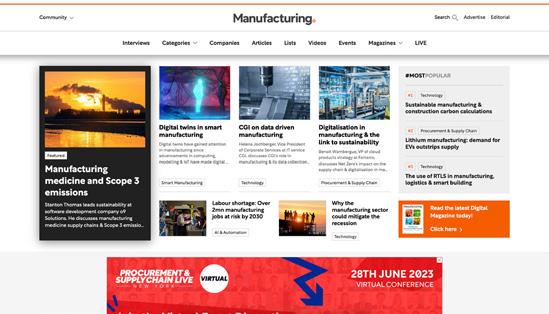




Digital Magazine
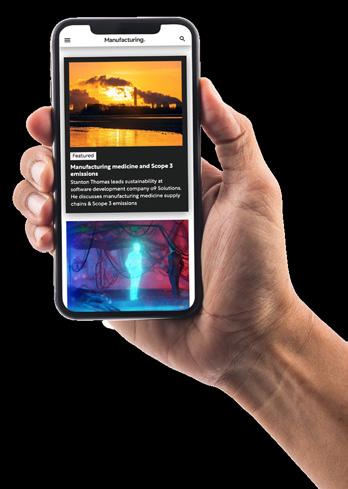
Website Newsletters
Industry Data & Demand Generation





Webinars: Creation & Promotion
White Papers & Research Reports

Lists: Top 10s & Top 100s
Events: Virtual & In-Person
WORK WITH US




In this issue, we look at the Top 10 sustainable manufacturers, Factories of the Future, and why the manufacturing sector is so well-suited to veterans once they return from service

Welcome back to Manufacturing Digital! In this issue, China Performance Group’s Coral Li & Aurora Zhai explore Factories of the Future and supply chains while Ralf Schedel, who leads market development at Giesecke+Devrient’s automotive business, shares his thoughts on the new expectations for car manufacturers.
Meanwhile, Laura Capper, Head of Manufacturing & Construction at NatWest, discusses how she helps manufacturers minimise energy costs and advance their sustainability credentials.

Finally, QAD Redzone’s Lance Olmstead talks about his journey back to civilian life after years of service and how the manufacturing sector can support veterans. We also take a look at the Top 10 most sustainable manufacturers – as we’re certainly going to need them. Keep looking up,
Helen.Adams@bizclikmedia.com

QAD Redzone’s Lance Olmstead talks about his journey back to civilian life after years of service and how the manufacturing sector can support veterans ”













Innovators are paving the way for a more resilient, sustainable and efficient future. The rules have changed. It’s time for DISRUPTION.
Tech LIVE Virtual returns to highlight the innovators changing the industry through expert keynote speakers, interactive fireside and panel discussions. This exclusive 1-day virtual event will bring together the greatest voices in the industry for an essential deep dive into the future of Technology, AI and Cyber.
Brought to you by BizClik, Technology, AI and Cyber Magazines, the event will shine a light on essential topics such as the AI revolution, quantum computing, the virtual workplace, technology’s place in sustainability and much more.
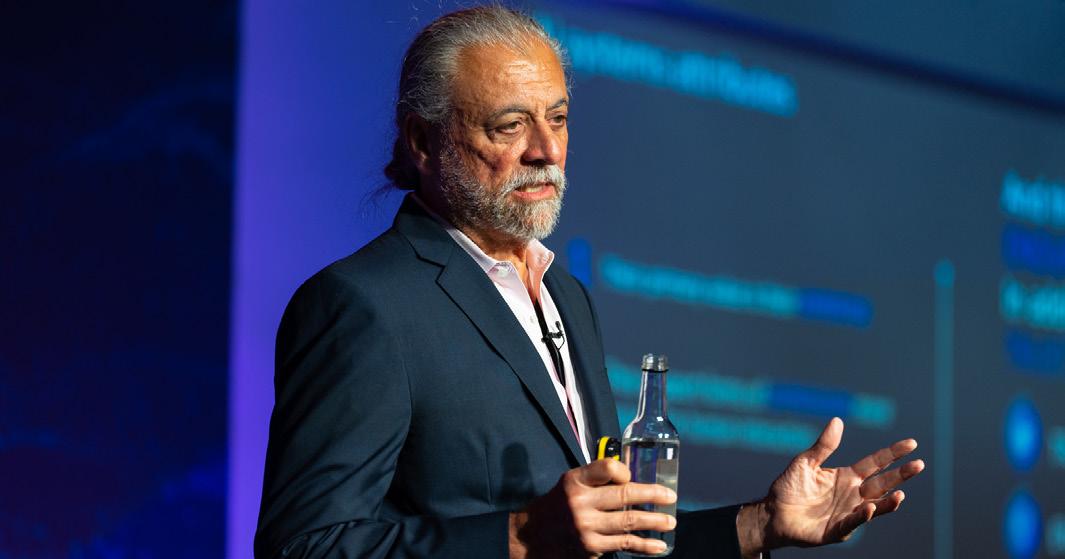
It’s time for DISRUPTION.



Position your business as a pioneer in Technology and showcase your values, products and services at Tech LIVE Virtual.





This is your chance to share your innovations with the technology community by making an impact in front of fellow decision-makers and influencers as well as accessing potential partners via an active and engaged audience.



See you on the 8th June 2023.

014 BIG PICTURE Manufacturers head for decarbonisation


016 FIVE MINS WITH Kanti Prabha is the President of contract lifecycle management company Sirion

020 LIFE TIME ACHIEVEMENT
Mary Barra is CEO of General Motors, a role she started in 2016, after beginning work at GM in 1980




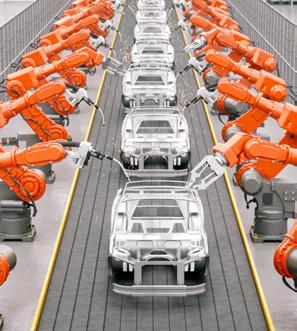
078 THE ROYAL MINT
Inside the tech-led reinvention of Britain’s coin maker
096 SUSTAINABILITY
Helping manufacturers reach their sustainability goals

104 MICROSOFT
Mike J. Walker at Microsoft empowers pharma supply chain innovations
120 TECHNOLOGY AND AI
Why veterans make an excellent fit in manufacturing
128 CAPGEMINI INVENT
Capgemini Invent helps companies hit their sustainable goals
146 TOP 10 Sustainable manufacturers
158 MICROSOFT
Microsoft empowering manufacturing firms to accelerate supply chain innovation

172 BIZERBA
Why Bizerba prides itself on being 'stronger together'
188 EVIDEN
The €5bn startup helping clients accelerate digital transformation


204 FARADAY FUTURE
The leader in luxury electric vehicles
096 078
104












Join the must-see virtual event disrupting procurement and supply chain on the 28th of June 2023.
This year, we are bringing you a solely virtual event, Procurement & SupplyChain LIVE Virtual will highlight the innovators changing the industry. Brought to you by BizClik, Procurement & SupplyChain LIVE Virtual will be held on 28th June 2023, streaming remotely to virtual audiences around the world.
The unmissable event will feature expert keynote speakers, interactive fireside and panel discussions, and more. Do not miss this 1-day deep dive into the disruption and the future of procurement, supply chain and logistics.
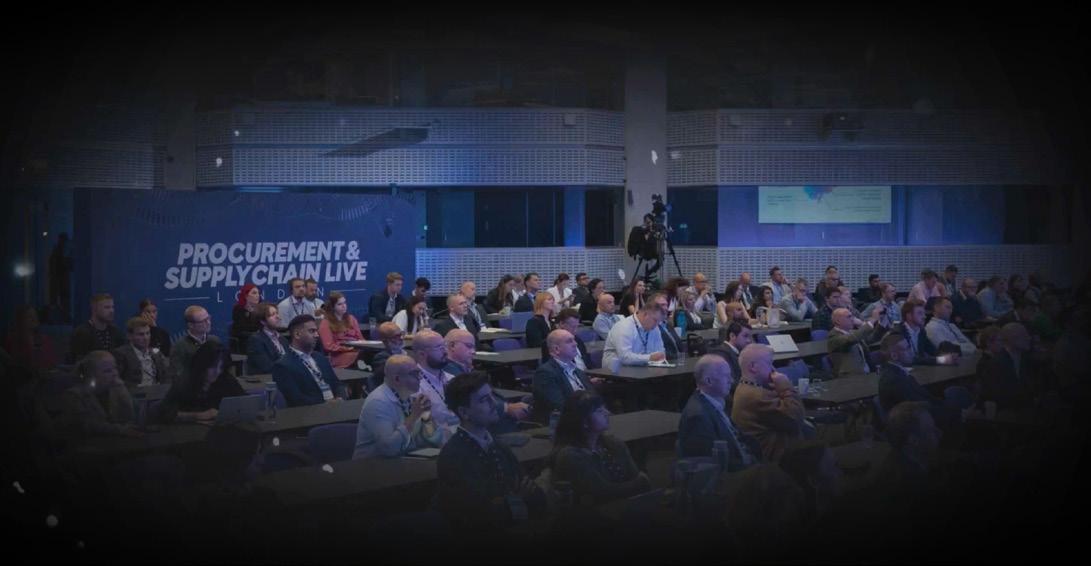
Do you want to position your brand in front of thousands of innovators, decision-makers and influencers?


Sponsor Procurement & SupplyChain LIVE to unlock the future of your business, access thousands of potential partners and influence businesses at the highest level.

Both global giants and innovative start-ups alike can discover the ideal platform with easy access to an engaged and active audience.
Contact a member of our team today to discuss sponsorship opportunities.
See you on 28th June 2023.
Innovators are paving the way for a more resilient, sustainable, and efficient future. The rules have changed. It’s time for disruption.▶ Watch our showreel from PROCUREMENT & SUPPLY CHAIN LIVE London 2022


83% of manufacturing businesses would like to decarbonise their vehicles and switch to EVs.
Cost, fears around efficiency, and a lack of infrastructure are delaying the EV evolution, yet many businesses have firm 2030 targets and sustainability goals.
Kanti Prabha is the President of contract lifecycle management company Sirion.

Sirion’s goal is to simplify how legal, procurement, finance and sales teams can author, negotiate and sign compliant contracts with embedded risk control, while being guided by AI-led contract intelligence.
TITLE: SAAS SPECIALIST COMPANY: SIRIONLABS
INDUSTRY: SOFTWARE DEVELOPMENT
LOCATION: CANADA
“I’m the Co-Founder and President of Sirion, a pioneering contract lifecycle management (CLM) company that fuses large language models – used by the likes of ChatGPT and best-in-class legal AI – to revolutionise how contracts are created, negotiated, and managed. As a founding member on the executive team, I’m deeply involved in guiding the product’s evolution, leading research and development around legal AI, and exploring its many applications and use cases within the CLM domain.”
» “After graduating with a degree in chemistry, I was leading a team of patent reviewers and working on developing techno-legal solutions for large enterprises at UnitedLex. That’s where I met Ajay Agrawal, and, after working with him for a few years, he invited me to join him in launching Sirion. Our first customer was HewlettPackard (HP). They reached out to us after a large acquisition, asking us to find a technological solution that would enable HP to centrally store thousands of contracts. We rose to the occasion by developing our own platform; and as we did, we realised that a repository was just one piece of the contract management puzzle that so many large
enterprises were struggling to solve. This idea inspired us to create Sirion, a true full-stack enterprise class CLM solution that not only enables businesses to store their contracts, but also create, negotiate, and manage the outcomes and value enshrined in them.
“Today, Sirion is used by more than 250 of the world’s most valuable companies in 70+ countries, to manage 5m+ contracts worth upwards of USD$450bn with a common goal: to build risk-free, valuedriven, highly-efficient contracts.”
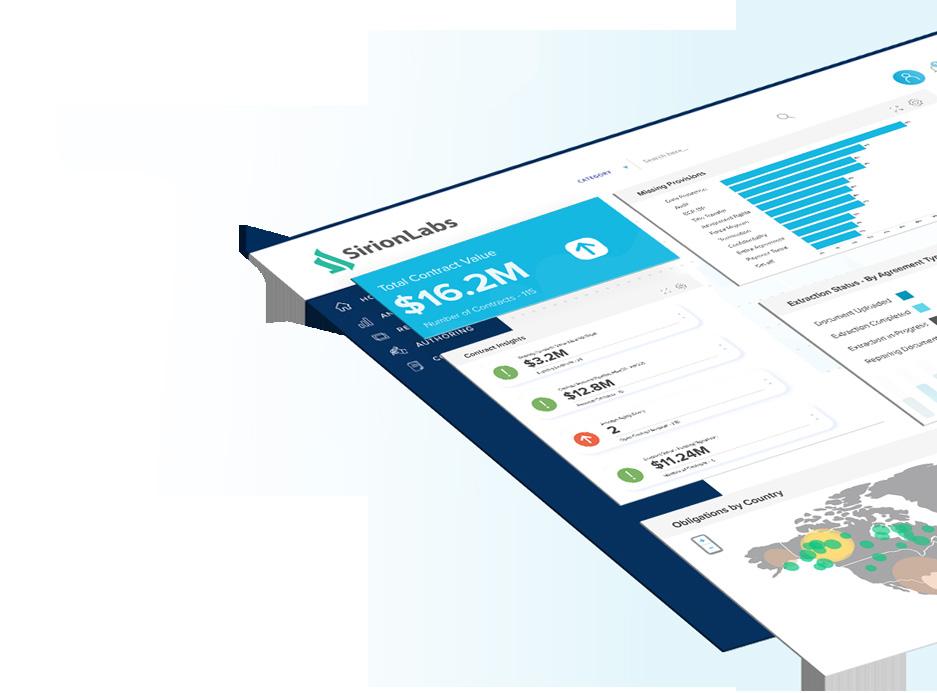
»
“Manufacturing operations today aren’t as simple as they used to be
“Manufacturing operations today aren’t as simple as they used to be even 25 years ago”
even 25 years ago. Supply chains have been stretching further and further in search of cost efficiency, fragmenting it into a delicately interconnected web of suppliers, subcontractors, and contract manufacturers. If we simply take the example of Apple’s iPhones, for instance, suppliers in 43 countries and six continents work together to build them. And that’s just the production side of it. When we add distribution to the mix, it grows even more complex with businesses having to manage multicountry, multi-region deals, rebate structures, and more.
“Now, think of this on a global scale. Decentralised buy- and sellside processes involving such a set of interdependent parts can lead to major discrepancies and several maverick operational silos within a single manufacturing value chain. The result: significant financial repercussions.
“This is the issue that Sirion CLM strives to solve. By creating a centralised, unified contracting process. CLM can standardise global processes, be it procurement or sales, both within the enterprise as well as across third-party partners. So, a manufacturer located in France can rest assured that their sourcing plant in Shenzhen or their distribution hub in Johannesburg are controlled by a centrally-enforced contracting process and risk playbook whenever they have to create, negotiate, sign or even renew an agreement.
“In addition, with a CLM in place, there’s visibility across their sourcing and distribution chains to ensure that everything is in compliance with local and global regulatory policies.”
» “When it comes to procurement, Sirion offers front-line, self-service contracting capabilities that allow enterprises to rapidly draft contracts, act on supplier information, surface and remediate risks hidden in contracts, and significantly shorten the legal review cycle. But this is only where it begins.
“Sirion is uniquely designed to not just simplify the pre-signature stage of a contract but to expand the scope of post-signature manageability of contracts. By mapping raw performance data extracted from the enterprise IT ecosystem, it allows procurement to defend revenue and realise hard savings to the tune of 6-12% at the invoice level.
“On the other hand, Sirion supports sales teams by cutting quote-to-contract time by as much as 80% and reducing the complexities of cross-functional
“Decentralised buy- and sellside processes can lead to discrepancies and several maverick operational silos within a single manufacturing value chain”
dependencies through self-service contract creation. Its AI-guided legal review capabilities help get the job done 90% faster, further saving enterprises’ time and effort. It also captures post-signature performance data, which can be used to lead account growth conversations.

“Moreover, Sirion helps vendors outline clear deliverables and gain full visibility for all parties involved throughout the course of the contract lifecycle, subsequently enabling better delivery performance and stronger relationships.”

» “We’ve just finished setting up our UX Center of Excellence in France –which is expected to have a significant impact on Sirion’s useability – and we’re

currently working on building out our AI R&D Center of Excellence in North America. The idea is to bring together the expertise and niche cognitive capabilities of Legal AI and the natural language processing power of the recently hyped large language models (LLMs), such as ChatGPT.
“At Sirion we believe that the future of contracting involves the combined power of these two distinct applications of AI. Although LLMs have the cognition to understand and generate natural language, Legal AI can enrich this capability with legal expertise and contextual understanding of contract language. Bringing these together will pave the way towards the future of autonomous, fully-computable contracting. This is what Sirion is working towards building.”
Mary Barra is CEO of General Motors, a role she started in 2016, after beginning work at GM in 1980

Mary Barra is Chair and Chief Executive Officer of General Motors. She aims to advance the customer experience and embolden GM’s core vehicle and services business, in addition to leading the mobility evolution through advanced technologies such as electrification and autonomous driving.
GM founder William Durant set the company up in Flint, Michigan, US. He had a lot of drive and a great deal of ambition: in 1886, he bought a horse cart company and, after some successful marketing at a local fair, received orders for more than 600 carts. 15 years later, the DurantDort Carriage Company had grown from a $2,000 investment to a USD$2m establishment and the largest vehicle manufacturer in the country. Durant became a millionaire by the age of 40 and was named the "King of Carriage Makers", before going on to found GM in 1908.
One century later, GM is leading the automotive industry in a world with ‘Zero Crashes, Zero Emissions and Zero Congestion’ – and CEO Mary Barra is at the helm.
From a co-op student to CEO at GM Barra started her career at GM back in 1980 as a General Motors Institute (Kettering University) co-op student at the Pontiac Motor Division. In 1985, Barra graduated with a Bachelor of Science degree in electrical engineering and she completed a Master of Business Administration from the Stanford Graduate School of Business later in 1990.
Barra took on several roles at GM on her way up to CEO. In 2011, she became Senior Vice President, Global Product Development. In 2013, Barra
was promoted to GM’s Executive Vice President, Global Product Development, Purchasing and Supply Chain.
Barra is Chair of the Business Roundtable and an association of chief executive officers of America’s leading companies, as well as serving on the Board of Directors of the Walt Disney Company, the Duke University Board of Trustees and the Detroit Economic Club.
Barra once said GM needed to “stop making crappy cars”, so that’s what GM did. During its third quarter, GM delivered strong results – including record third-quarter revenue despite supply chain challenges.
MARY BARRA
TITLE: CEO
COMPANY: GENERAL MOTORS
INDUSTRY: MANUFACTURING
LOCATION: DETROIT
Mary Barra is the Chair and Chief Executive Officer of General Motors. She arrived at the company in 1985 while studying at Kettering University. She became Vice President of 2008 and, in 2016, earned the role of CEO.
Barra is responsible for leading the Board of Directors, establishing General Motors' strategic direction and managing the company’s dayto-day global operations, which stretch across 125 countries.
Barra is dedicated to leading GM ‘towards a future of zero crashes, zero emissions and zero congestion’.


These results will keep GM on the right track: this is the company’s third consecutive year of full-size pickup leadership and its 22nd year as the fullsize SUV leader.

GM earned more than 8% of the US electric vehicle market in this quarter due to extraordinary sales of the Chevrolet Bolt EV and Bolt EUV.
“The GM team continues to deliver incredible results, and our Q3 earnings report is evidence of that,” said Barra.
General Motors’ automotive vision is to build a world with no crashes, emissions or congestion, and it is also dedicated to zero exclusion. As an inclusive company, GM is proud of the welcoming environment it has made over the past decades, where ‘everyone feels welcomed and valued for who they are’. The 167,000 GM employees are encouraged to bring wide-ranging perspectives and experiences to solve supply chain and sustainability challenges.
“Diversity is all about the pipeline,” Barra said. “It’s not just about gender, but about all forms of diversity. At GM, when we search for executive candidates, we require a diverse slate. If we find that a position has no diverse candidate, I ask the question, ‘What are we doing so that three years from now there will be a diverse candidate to consider?’”
GM is proud to be leading equal representation from an executive level and will welcome the day when female leadership is the norm. Barra is a founding member of GM’s Inclusion Advisory Board, on which she serves as the Chair.
“The success of every company is about its people,” Barra told Michigan Daily. “I make sure I understand key parts of the business and, having worked in an assembly plant, having been a plant manager, having been responsible for product development, having understood HR – all of those things really round out to give me a lot of the skills that I need as CEO.”
“Diversity is all about the pipeline. And it’s not just about gender, but about all forms of diversity”




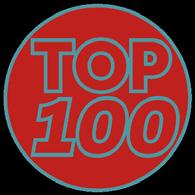


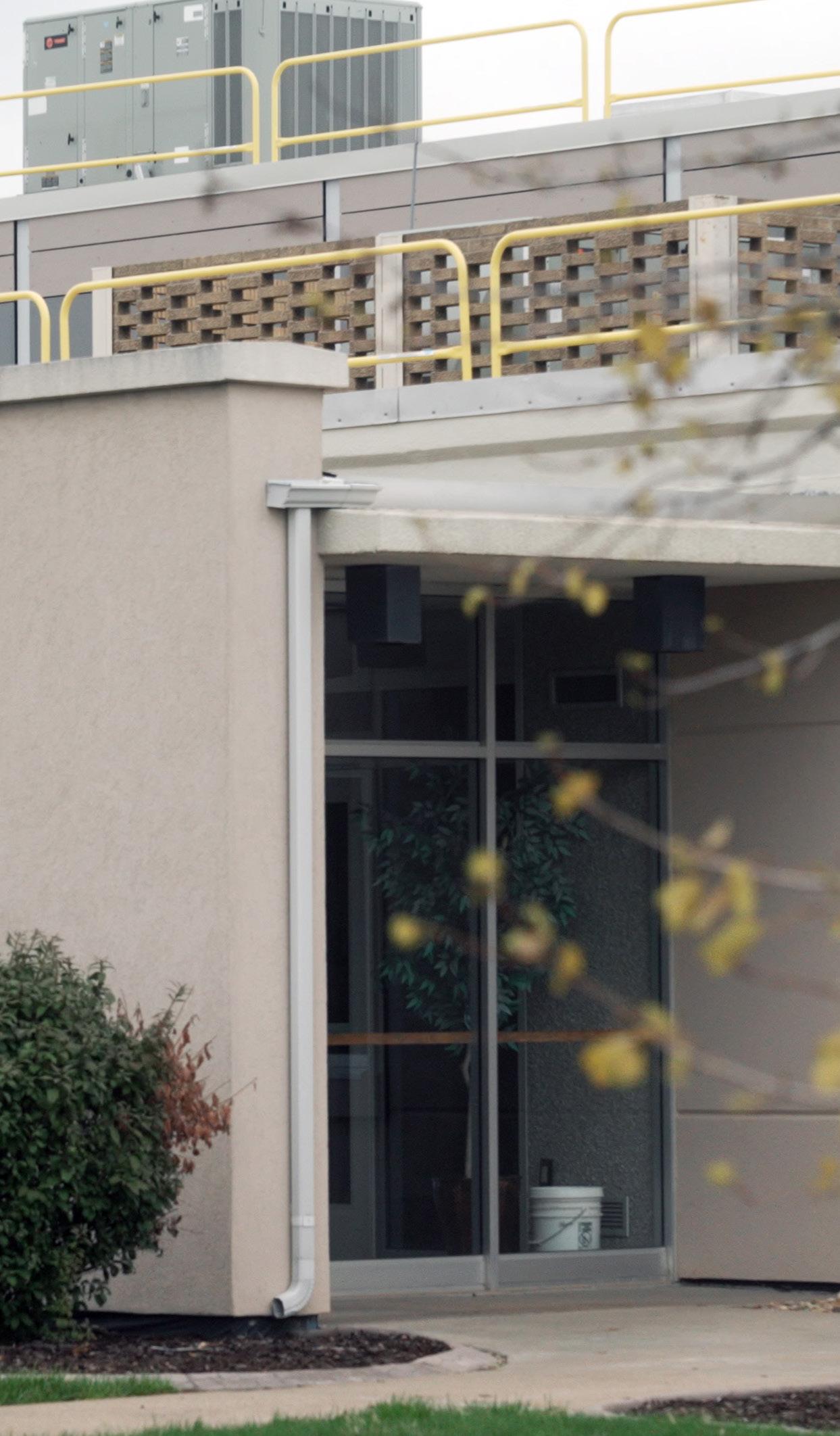
 WRITTEN BY: HELEN ADAMS
PRODUCED BY: MIKE SADR
WRITTEN BY: HELEN ADAMS
PRODUCED BY: MIKE SADR
Kevin Nelson is the Chief Procurement Officer at BD (Becton, Dickinson and Company), a medical technology company based in Franklin Lakes, New Jersey. His responsibilities include overseeing all third-party spend, including direct and indirect.
“I’ve been in the procurement profession for a number of years, starting my career in the high-tech industry and evolving into roles within the biotechnology arena before leading strategic sourcing at C. R. Bard, a medical device company that BD acquired about six years ago,” he says.
BD is one of the world’s largest medical technology companies. Its purpose is ‘advancing the world of health’ by improving medical discovery, diagnostics and the delivery of care.
“Roughly 90% of patients coming into a clinical setting in the United States are going to use a BD product,” says Nelson.
Products vary from well-known medical devices such as needles, syringes and blood collection tubes to sophisticated electromechanical devices, diagnostic instruments and reagents.
COVID-19 changed the world foreverhybrid working is the new normal, face masks are as common as earrings and you never leave your house without your keys,

how his team mitigates supply chain risks and delivers innovative solutions in an ethical way

Gainfront’s AI driven technology platform is designed to increase procurement efficiency while solving the unique procurement process challenges that arise from today’s remote and hybrid work environments and increased focus on corporate social responsibility around supplier diversity, ethical compliance, and reducing green house gas emissions

Gainfront’s highly customisable, modular, procure-to-pay powerhouse platform for Diversity, ESG, and collaboration
Gainfront is a platform that meets the procurement needs of today’s business landscape, focusing on mandates related to diversity, supplier diversity, workforce diversity, as well as ESG tracking. Led by Hetal Mehta, CEO of Gainfront, the company provides organisations with an innovative way to achieve compliance to preferred buying while offering powerful workflow automation, which is essential in today’s hybrid work environment.

Gainfront enables customers to easily configure their workflows, whether in sourcing, finance, or HR, granting them full control over the process through team collaboration and audit trails. As a complete Procure-to-Pay platform, Gainfront fully embraces diversity, ESG, and workflow automation requirements, providing a comprehensive solution for procurement professionals.
Gainfront recognises the pressing need for finding new, diverse, and environmentally conscious suppliers on a global scale. With current supply chain challenges, customers often struggle to identify and source from new suppliers. Gainfront addresses this issue by offering their customers access to a strong and robust global Discovery database. Mehta highlights the importance of this database, stating that it resolves the problem of customers being unable to replace suppliers due to a lack of viable alternatives.
In the context of today’s hybrid work environment, there is a growing need to find qualified suppliers while managing risk profiles. Gainfront introduces the RFX Concierge service, which allows customers to source suppliers easily by providing preliminary criteria. By leveraging this service, Gainfront identifies qualified suppliers and connects them, significantly reducing customers’ search time by almost 60%.
“Gainfront recognises the importance of collaboration in today’s hybrid work environment,” says Mehta. “The company’s horizontal approach to workflow automation provides customers with team collaboration capabilities, allowing for efficient communication and tracking of audit trails. By gathering all decision-making processes in a team-collaboration environment, individuals are held accountable, mitigating the risk of miscommunication or lost information.”
Gainfront’s Partnership with Becton Dickinson (BD) Becton Dickinson (BD) has been a customer of Gainfront for the past three years. Mehta and her team have been instrumental in helping BD manage supplier diversity, spend management, and tracking, thereby assisting them in achieving their BDR goals. Through Gainfront’s database, BD gains access to new suppliers, enabling them to meet their sourcing and diversity goals successfully.
wallet, phone and hand sanitiser. The postpandemic planet changed the procurement process too, especially for those dealing with medical equipment.

“The world has changed and our supply chains need to adapt,” said Nelson. “When we look at the environment, or the world around us right now, we are continuing to see more disruptions every year. We’ve been tracking this, not only within BD, but also within the healthcare and the life sciences industry.”
More frequent disruptions in the supply chain are happening year over year, which include plant shutdowns, supplier shutdowns, supplier insolvency, port strikes, geopolitical tensions and more.
“BD has taken this ‘moment’ to lead a ‘movement’ to create the supply chain of the future, and that all starts with enhanced procurement visibility and agility”
KEVIN NELSON SENIOR VP & CPO, BD
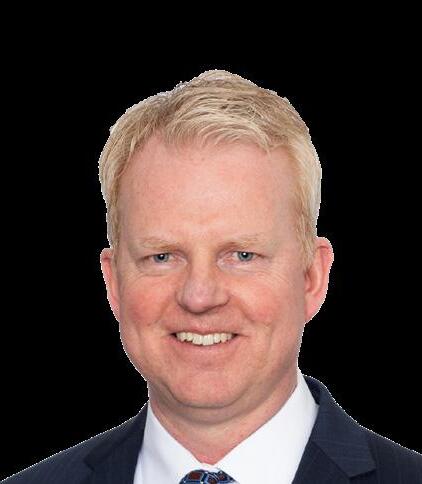
TITLE: SENIOR VP & CPO
COMPANY: BD
INDUSTRY: MANUFACTURING
LOCATION: NEW JERSEY, US
Kevin Nelson has served as BD’s SVP and Chief Procurement Officer for the past five years focused on applying advanced Procurement strategies to help BD navigate supply chain disruptions and inflationary challenges during the pandemic. Kevin created BD’s Responsible Sourcing Program which strives to develop an ethical, agile supply chain capable of sustaining external pressures.
Prior to B, Kevin was VP of Global Strategic Sourcing C.R. Bard where he introduced an advanced sourcing methodology that delivered solid yearover-year savings as well as additional value through innovative supplier relationship management, revenue generation, reduced backorder and a supplier risk management program.
“All these things result in some sort of disruption to the supply chain,” says Nelson. “We have continued to see that and experience it. That has led us to asking, what do we need to do differently? Because we’re probably not going to get back to this ‘normal’ that everyone’s been waiting for. BD has taken this ‘moment’ to lead a ‘movement’ to create the supply chain of the future, and that all starts with enhanced supply chain visibility and agility.”
This “movement” at BD has resulted in multiple initiatives to evolve procurement strategies to be more resilient, agile and socially responsible.

Kevin received his B.A. from the University of North Dakota and MBA from Boston University. Kevin is a member of the Healthcare Transparency Institute, Strategic Marketplace Initiative, National Minority Supplier Development Committee, Institute for Supply Management and sits on multiple advisory boards in the medical device industry.


Enhanced visibility via AI & ML

“To start building our supply chain of the future, we mapped our product lines to identify which ones are considered critical to healthcare,” Nelson explains. “These are products that the healthcare industry has
deemed essential to care for the patients, and if they aren’t on the market, there’ll be a problem around meeting basic or routine healthcare needs.”
BD identified over a hundred different product lines that are critical to healthcare. Nelson and his team conducted an assessment on every product line, looking at every item in the bills of materials and ensured remediation is in place for the critical high-risk materials.

“A product line may have a few items in the bill of materials, or it may have a few hundred items. We do an assessment on every item in that bill of materials and on every supplier, to see where potential risks are.”
BD creates a composite score that allows them to plot product lines to see which ones are in a high-risk quadrant.
“We’re looking at how we can help a community where our customers are living”
BD: Ensuring a resilient, responsible and agile supply chain
KEVIN NELSON SENIOR VP & CPO, BD
“We can take that back to our business units and work with them to create mitigation plans to dual source, adjust inventory levels, and/or regionally source some of the material or components.”
90%
As part of the work to de-risk high-priority products, BD uses discovery technology that employs AI and machine learning ML to map subtier supply chains for critical products and leveraged that visibility to uncover hidden risks in its suppliers’ extended supply chains.

“During COVID-19, 80% of BD’s supply chain disruptions didn’t come from our direct suppliers,” Nelson adds. “They came from our suppliers’ suppliers or even three or four levels down the chain. Unless you have mapped your entire supply chain and employ
very sophisticated technology, it is very hard to know how a disruption at a third or fourth-tier supplier will impact your product.”
An example of the payoff of this work was a recent paper strike in Finland. Because BD mapped the supply chain, the procurement team knew that pulp from Finland was used in medical grade labels the company uses and that there were very few alternate suppliers. BD received early warning signals from the risk intelligence partner along with the visibility to understand the issue early on, work with its partners to find alternate sources and secure inventory of labels well in advance of other companies or industries that would be vying for the same label stock.
Roughly 90% of patients coming into a clinical setting in the United States are going to use a BD product
The life sciences industry continues to experience unparalleled innovation as investment and talent flow into the sector and breakthrough discoveries happen at a rapid pace.
Named the 2021 BD Sustainability Supplier of the Year, JLL helps life sciences companies create compelling real estate and facilities strategies that improve efficiency, mitigate risk and deliver a sustainable workplace. Lay the groundwork for rapid growth →

Creating a socially & environmentally responsible supply chain BD knows its customers want them to provide high-quality products at a fair price and that they expect more than the basics. Improved resiliency, visibility and agility are adding value, but the company is also focusing on sustainable business practices that are environmentally, ethically and socially responsible.
“At BD, we stay true to our values, including doing what is right. We set up the Responsible Sourcing Program to ensure we embed supplier responsibility and sustainability in every purchasing decision we make,” Nelson explains.
This includes partnering with ethical and diverse suppliers, helping protect human rights and working to ensure environmental stewardship.
“Our customers want to understand the bigger picture, too,” Nelson explains. “Are they buying a product from us that is sourced from an ethical and responsible supplier paying fair wages to its workers?”
BD ensures compliance in these areas through ongoing assessments, desktop and face-to-face audits and close partnerships across its supply base. This is all to ensure that suppliers understand exactly what BD

“Unless you have mapped your entire supply chain and employ very sophisticated technology, it is very hard to know how a disruption at a fifth-level supplier will impact your product”


expects when doing business with them, while also making sure risks are anticipated and managed effectively.
Like most companies, Nelson and his team have certainly found some areas of concern in their network that need to improve.
“Instead of moving away from that supplier and letting it be someone else’s problem, we’ve tried to see how we can work with them to identify an area they need to improve in. If they’re able to, that’s great. If not, then we’d have to move away. So far, we’ve been successful in mitigating issues. We’re working to help improve human rights around the world while ensuring important medical products get to those who need them.”
Another focus area of BD’s Responsible Sourcing Program is supplier sustainability. This examines where suppliers are driving reductions in greenhouse gases, diverting waste away from landfills and understanding how much renewable energy they use. The Responsible Sourcing team is also working internally with product stewardship and category management to develop and implement strategies to eliminate materials of concern where possible.


“The partnership is that three-legged stool: our customer, our internal stakeholders and our suppliers”
KEVIN NELSON SENIOR VP & CPO, BD
How well do you know your suppliers?
Or even your suppliers’ supplier?

Get clear visibility and unmatched intelligence to make faster, smarter supply chain decisions. Everstream reveals supplier, material, and revenue risk before anyone else. With the world’s most accurate and reliable data, network graphing, and human analysis, Everstream empowers supply chain leaders to build strong, agile, and sustainable supply chains.
Take control of your supply chain with Everstream everstream.ai
everstream.ai/demo
KEVIN NELSON SENIOR VP & CPO, BDsustainable sterilisation technologies, and addressing materials of concern (MOC).
The third area of focus of the Responsible Sourcing Program is supplier diversity, which has gained a lot of momentum in the US.
“We pivoted our supplier diversity focus from one that historically assessed our spend with small businesses and diverse suppliers, which was more of a reactive approach. Today, we are looking at economic impact in terms of how we’re helping different regions and local economies by using diverse and small businesses that are truly making an impact. We’re looking at how we can help a community where our customers are living,” explains Nelson.
“The Supplier Sustainability pillar includes working alongside our R&D team and business units to identify products, materials and components that are ‘greener’ in nature while also making products that are more effective, efficient and economical,” Nelson explains. “This might be a packaging component that uses less energy to make or is recyclable.”
In 2022, BD launched the Sustainable Medical Technology Institute, a model of practice within the organisation that brings together BD researchers and engineers, as well as quality, regulatory, policy, sourcing and operational expertise, to focus on reducing the environmental impact of the company’s product portfolio in three areas: adopting sustainable product design strategies, developing and deploying
Finally, there’s end-to-end transparency, which is connecting back to the customer and providing enhanced visibility to them. “The key is providing this information proactively and transparently to the customers, to the patients, before it’s a problem, so they have the ability to do something in advance.”
As with any medical manufacturer, BD’s partner ecosystem is vast.
“Partnering with our customers upfront is a key priority for BD. We aim to identify the customer requirements and expectations and build those into our long term strategies and initiatives,” he explains.
From day one, BD’s style has been to collaborate and work with its partners, which was essential during the pandemic.
“We came in working together, wanting to figure out a solution with our supplier partners, as opposed to demanding, ‘Shift this or I’m going to move away from you’.
“Instead of moving away from that supplier, we’ve tried to see how we can work with them to identify how they can improve”

“The partnership is a three-legged stool: our customer, our suppliers and our internal stakeholders that includes business units, Quality and Regulatory, among others.”
This work is further strengthened through strategic collaboration and public-private partnerships with government agencies, including the FDA, HHS, POTUS/White House – and industry collaboratives like Advamed – to address supply chain and sourcing issues that plague the broader healthcare industry.
Being able to incorporate those areas into BD’s strategy has allowed what Nelson sees as a resilient end-to-end supply chain.
The momentum of BD’s procurement supply chain team has been exciting for Nelson and his team.

“We’ve experienced very little turnover in our function, and I think a big reason for that is that people see the movement we are driving and understand we have become extremely vital to BD, our customers and the patients they serve. We are on the frontlines; we are helping shape strategy as we go forward here.”
Nelson views this as an entirely different kind of mindset and even acumen, from a team perspective.
“I think it’s been refreshing for the team to pivot away from historical firefighting or cost-reduction to facing the bigger opportunity we’re trying to address.”
“We have more engineers on the team now doing more,” says Nelson. “Our engineers look at an existing product line and see what we can do to redesign elements that can meet the needs of our customer and patients, reduce our overall risk exposure and benefit BD as well.”
China Performance Group’s Coral Li & Aurora Zhai discuss digital twins, ‘Factories

28.7%
of the world’s manufacturing output takes place in China. The north-eastern coastal city of Shanghai is its biggest hub, with over 2,000 container ships leaving the port each month delivering cars, electronics, and clothes to the world. Megacity Beijing is home to 21mn people and thousands of businesses – including China Performance Group.
Coral Li is the Sourcing Manager at CPG’s Beijing office, where she manages the work of CPG’s Sourcing and Quality Assurance teams to ensure clients’ short- and longterm China-sourcing goals are achieved in a cost-efficient way, both in terms of time and money.
“China Performance Group (CPG) provides support to importers who seek excellence from their China supply chain management. We use a transparent, fee-based approach, ‘The China Sourcing Solution’, which enables
global companies to manage complicated business transactions from afar and enjoy all the benefits of their own professional China office without any of the burdens,” Li explains. “Our approach provides companies with a dedicated sourcing team and branch office in China, tailored to their specific needs and objectives. The CPG team manages all the company's sourcing processes to deliver predictable, repeatable results.”
At CPG, Factories of the Future will play a big role.
“The ‘future factory’ will have digitalisation at its core, running with the aid of digital twins, artificial intelligence, big data, and constantly evolving production that requires innovative information technology. Through the digitalisation of R&D, production, manufacturing, marketing, and management, enterprises will run based

Wipro’s products on AWS such as condition-based monitoring, smart track and trace, and production monitoring and process automation provide smart monitoring technologies, data collection and analysis, product development, supply chain modernization, and maintenance recommendations that revolutionize manufacturing efforts.

Read more about Wipro Industry Solutions on AWS

manufacturers achieve digital transformation quickly and seamlessly.
on the calibration of data and subsequent predictions,” says Li.
Aurora Zhai is a Sourcing Specialist at China Performance Group, where she manages and executes clients’ projects on the China side.
“At China Performance Group, we help importers source goods from China safely, responsibly, and effectively. We enable international buyers to obtain the maximum benefits of doing business with China – while significantly reducing their risk.
“My primary job responsibilities include sourcing, helping clients find the most suitable suppliers in China for existing products and new product development, as well as price benchmarking, order management, shipping management and logistics,” explains Zhai.
CPG supports manufacturers in a variety of ways, from helping to build positive relationships to guiding suppliers through a supply chain crisis.

“We connect them with serious buyers, facilitate communication and help to forge a professional, close, transparent client-buyer relationship,” says Zhai.
Zhai’s support for her clients also helps manufacturers by enabling them to perform
“The ‘future factory’ will have digitalisation at its core, and run with digital twins, artificial intelligence and big data”
LI SOURCING MANAGER, CHINA PERFORMANCE GROUP
better and in close accordance with the buyer’s wishes.
“We do this by providing timely feedback to suppliers on client’s requirements, goals, responses, and this strengthens the relationship,” says Zhai. “We collect information on industry segments and market trends for our clients and provide suppliers with the latest foreign market and product trends that the buyers want.”
Over the past few years, Zhai has learned a lot about supply chain management.
“One of the easiest, most fundamental ways CPG helps clients navigate the
supply chain crisis is by finding back-up and alternative suppliers in advance. By doing this, we gain leverage; we can calmly address any problem and still meet clients' requirements on pricing, quality, and delivery should issues arise,” says Zhai.
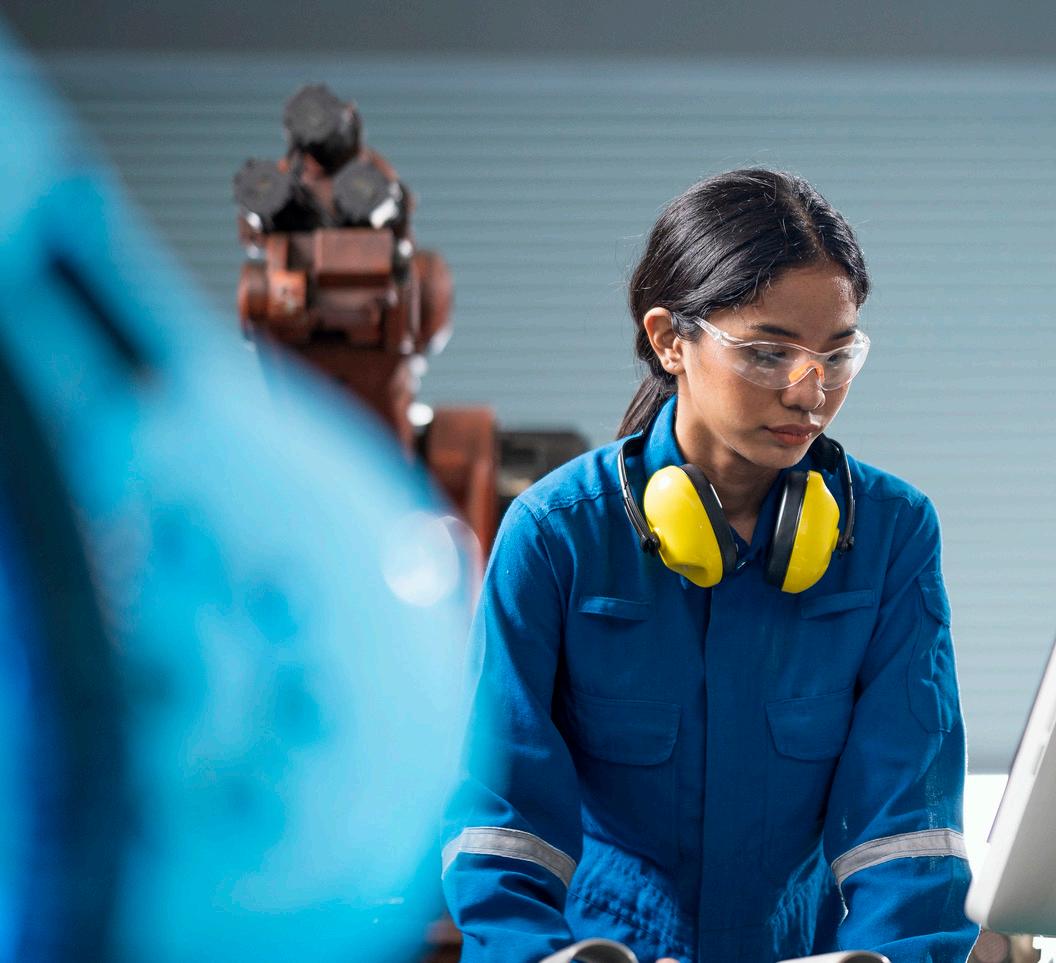
To build successful supply chain management, Zhai claims that transparency and information sharing helps build trustbut more is needed.
“Continued rapport building and cooperation between supply chain stakeholders is also essential,” says Zhai. “As well as ongoing training and
learning to facilitate innovation and continuous improvement.”
Every business on the planet has learned lessons from the supply chain crisis. At CPG, its careful coordination between clients and suppliers has solved problems and made partnerships stronger.
“Without identifying the root cause of a problem, how can one manage or resolve it effectively?” asks Li. Here, she shares her supply chain survival tips:

Act quickly to prevent a crisis
“Preventing or resolving a supply chain crisis
“Through digitalisation of R&D, production, manufacturing and management, enterprises will run based on the calibration of data and subsequent predictions”
SOURCING MANAGER, CHINA PERFORMANCE GROUP
requires immediate and effective solutions. CPG can provide clients with numerous approaches to choose from that can significantly mitigate their risk based on our years of experience working on the frontlines and dealing with thousands of mainland suppliers, coupled with our inherent understanding of the client’s vision and the local culture.”
“While many issues occur suddenly, many also provide warning signs that can alert you to a potential crisis before it happens. For example, if you know a supplier well enough, every abnormal or atypical reaction to a client request can betray the possibility that something might be amiss.
“Furthermore, market signals and changes to government policies are always good indicators to buyers that they might need to make preemptive adjustments to their sourcing programmes. The better you know
your supplier and the market, the earlier you can anticipate and prevent any potential risk.”

Over the next year, CPG will launch the following initiatives to ensure they maintain the highest standards of service for clients.
The ongoing training of employees will include repeat training and assessment of valued sourcing procedures, alongside training on new technologies and data analysis platforms. Team members will also participate in industry seminars.
“CPG participates in seminars related to our client’s industries, gathers and analyses market data, and writes quarterly market reports that are shared internally, and with our clients as requested,” explains Li. “This enables both CPG and our clients to understand the pulse of their industry and its trends, so we can adjust our sourcing goals and work accordingly.
Buy Direct From China“CPG will also hold weekly client management meetings to ensure client project missions are clarified, executed, and completed in the most satisfactory and efficient manner. Issues are solved quickly and thoroughly through teamwork and brainstorming,” says Li.
For Zhai, the next year will involve identifying new opportunities for clients that may not be readily apparent to them based on CPG’s continued vision and interaction with the China manufacturing sector.
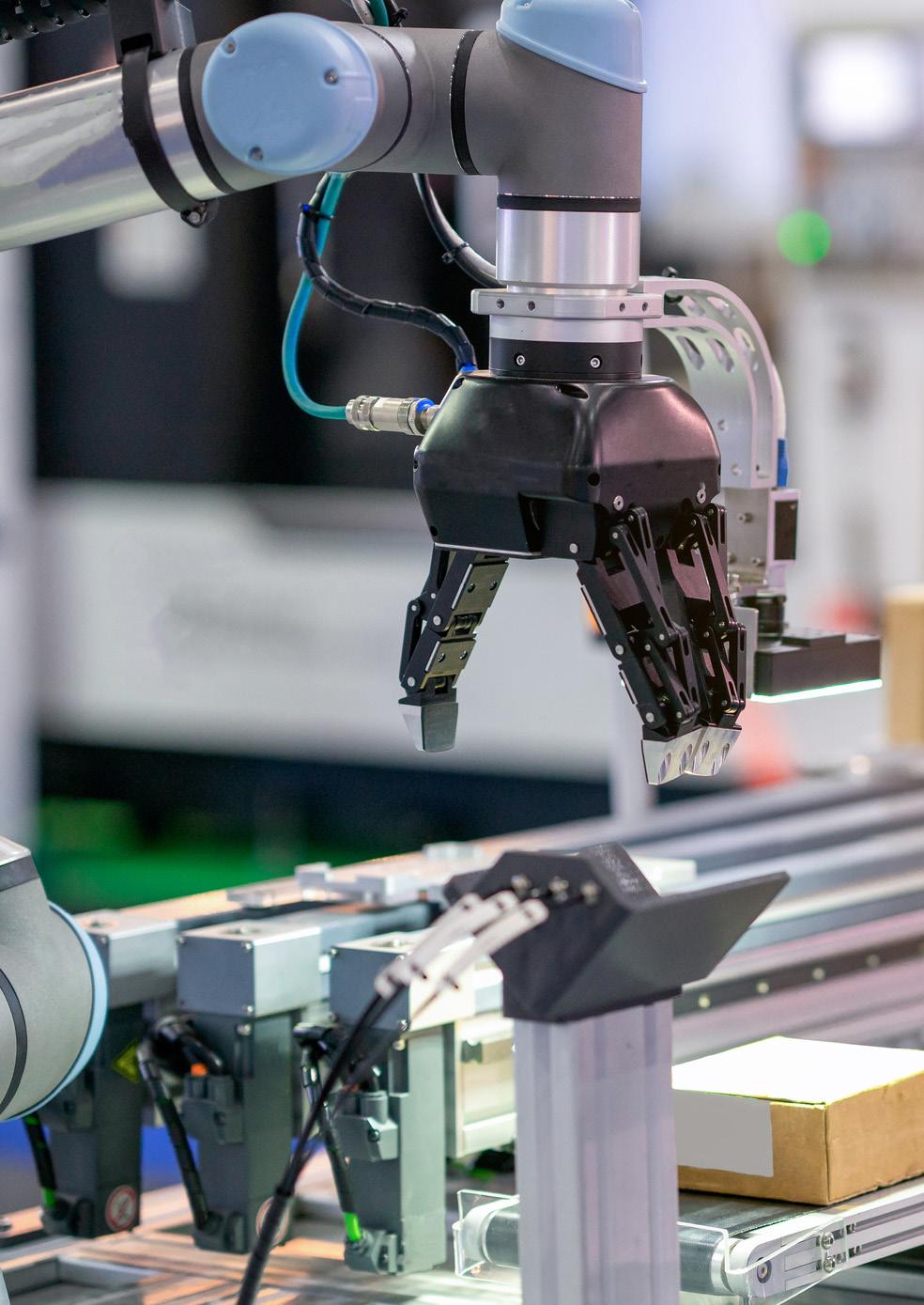
“We connect manufacturers with serious buyers, facilitate communication and help to forge a close, professional and transparent clientbuyer relationship”
AURORA ZHAI SOURCING SPECIALIST, CHINA PERFORMANCE GROUP







United Urology Group (UUG) is a US-based national network of 1,500 urology healthcarefocused employees. It has affiliate practices in Arizona, Colorado, Delaware, Maryland, and Tennessee.
Founded in 2016 and with its HQ in Maryland, it supports 220 providers in 95 locations across five states, making it one of the largest urology networks in the US.
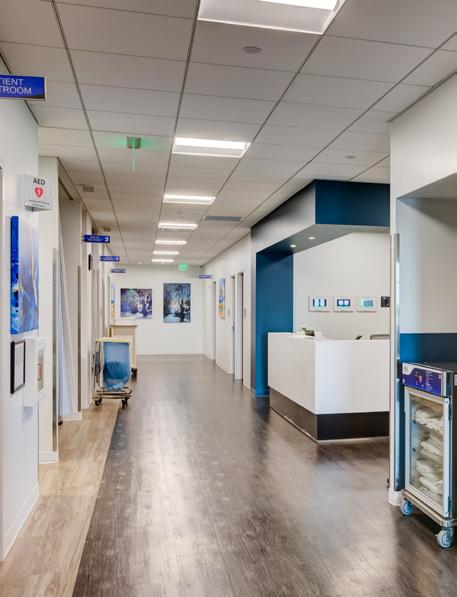
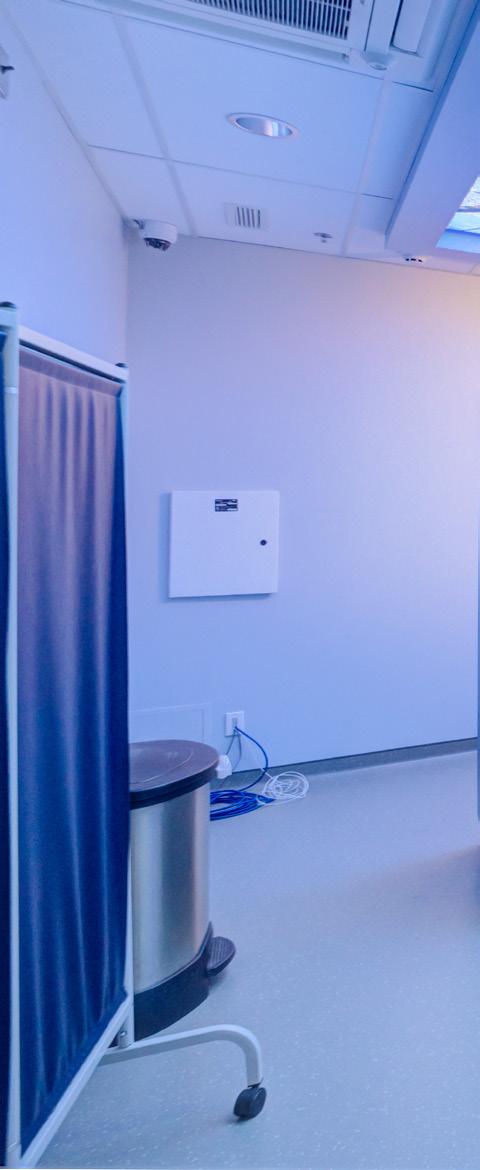
At heart, UUG is a management services organisation (MSO), providing administrative and support services to urology practices across the United States. This support includes revenue cycle management, financial management, human resources, marketing, and strategic planning.
David Forbes is VP of Supply Chain Management for UUG and is responsible for its source-to-pay programme, strategic sourcing, procurement, and accounts payable. He also provides consulting services in inventory management for UUG clinics.
The support Forbes and his team provide includes everything from human resources and sourcing services to IT.
He says: “I source contracts for my practices. I aggregate everybody's spend and negotiate the best possible agreements with the right trading partners at the right level.”
Why supply chain is a point of difference for US-based healthcare management services organisation, United Urology Group



Forbes also offers procurement support, or “day-to-day blocking and tackling” as he describes it. Accounts payable is another of his areas, and his team also ‘owns’ the company’s source-to-pay solution that serves its physician practices.

UUG’s network of practices are known for their integrated urologic care programs, a patient-first approach, clinical excellence, and innovative treatments for

a wide range of urologic conditions, from the most common to the most complex cases.

“We aim to support our affiliated practices in providing high-quality, patient-centred care,” he says, “and to support our affiliated practices in delivering care in an efficient and effective manner.”
UUG’s supply chain organisation is vital to this goal, says Forbes, who explains that it helps the
DAVID FORBES VP SUPPLY CHAIN MANAGEMENT, UNITED UROLOGY GROUP
“We aim to provide high-quality, patientcentred care”
company deliver on its Quadruple Aim strategy, comprising:
• Clinical efficacy
• Patient experience
• Clinician experience
• Cost takeout
“These are four metrics our practices look to base decisions on, whether small or major,” says Forbes.
He adds: “Clinical efficacy is about whether or not a decision made by our affiliated practices improve patient outcomes. Clinician experience refers to the experience

TITLE: VP SUPPLY CHAIN MANAGEMENT
COMPANY: UNITED UROLOGY GROUP
INDUSTRY: HEALTHCARE
David Forbes is a seasoned supply chain professional with almost two decades of experience. Currently serving as the VP of Supply Chain Management for United Urology Group, his team is responsible for providing end-toend source-to-pay support to over 220 urologists and advanced practice practitioners. David's extensive experience includes working with the Healthcare Industry Distributors Association to develop healthcare trading partner data communication standards, building value analysis and sourcing departments for a hospital-based system, and serving as a strategic sourcing consultant with The Advisory Board Company. He holds a B.S. in Business from Miami University and an MBA from Loyola University Maryland.




“Shortages and back orders are the toughest part of the job. In the healthcare industry, we've never seen it as bad as it is right now”
DAVID FORBES VP SUPPLY CHAIN MANAGEMENT, UNITED UROLOGY GROUP
of physicians, nurses, and medical assistants when using the product or service.”
Patient experience, he explains, concerns factors such as patient comfort and recovery each of which “are key considerations in cost takeout”.
Forbes cites as an example the purchase of a simple piece of urological equipment, such as a catheter.
“Cost takeout is about what we can do to prune unnecessary costs from healthcare, but it is not always about monetary cost. I might be able to negotiate a fantastic deal on the latest foley catheter, say, but if this product is going to cause urinary tract infections, or if it’s difficult to insert or remove, then it doesn't make sense to do it.”
Supply chain, he says, helps UUG deliver on its Quadruple Aim metrics.
“The obvious one is cost takeout, and the rest are impacted through the clinical integration of my department with our physician practices.”
220
Number of providers UUG has for its urology practices

95
Number of locations
5
Number of US states covered
Specialty Networks and United Urology Group have partnered over the past decade to better practices across the group and improve patient care. The common focus on improvement in every area, along with clinical integration throughout, promotes consistent advancement at a clinical level.

Specialty Networks, partnered with United Urology Group since 2013, enhancing practice performance through data, events, and group purchasing support.


Specialty Networks is the parent organisation of companies including group purchasing organisation UroGPO, of which United Urology Group is a member.
Specialty Networks has presence in multiple specialties
As a multi-specialist organisation, Specialty Networks has deployed GPOs in urology, gastroenterology, and rheumatology, alongside a robust data analytics platform (PPS Analytics) and also a research arm. The latter supports members like United Urology in conducting research inside their practices, with a data analytics arm to support practices while addressing gaps in care.
“The GPO establishes best-in-class purchasing agreements with manufacturers in areas including pharmaceuticals, services, and medical devices,”
Darren Dieleman, Senior Vice President at Specialty Networks, says. “We’re aggregating not just United Urology Group, but also the other 720 urology practices across the country into one buying group, then negotiating value-added programs with manufacturers to support the individual members.”
The partnership with United Urology Group
“What’s unique about the relationship between United Urology Group and Specialty Networks
via UroGPO is the fact that we share the common customer of our physician practices,” explains David Forbes, the Vice President of Supply Chain Management for United Urology Group. Alongside the benefits of the GPO, United Urology Group also utilises PPS Analytics – the data analytics arm of Specialty Networks – to streamline and identify potential gaps in patient care.
“We also run customised educational events at their individual pods and a series of live events across the country,” Dieleman explains. “We’re running a summit for United Urology in May to allow their practices, many acquired during the pandemic, to come together to establish longterm goals and objectives, network, and attend educational podium sessions.”
What’s next for the partnership?
“Live events, purchasing, reporting – there’s a much larger strategy ahead of us to help United Urology Group achieve in aggregate what they wanted to achieve individually as independent practices,” says Dieleman.
Specialty Networks and United Urology are moving forward with a hands-on approach to continually bettering themselves, the practices, and, therefore, patient care.
He adds: “This is why it's really important that as a supply chain organisation we’re closely aligned with the clinicians, so that we can be sure to execute on our collective goals.”
UUG is plugged into a large ecosystem of businesses who help it deliver on its goals.
These include:
• Specialty Networks
A niche group-purchasing organisation that negotiates agreements for specialty products, most prominently branded oncology pharmaceuticals.
• Medline
Medical-surgical distributor Medline is a key supplier. “We recently partnered with Medline because they are designed to scale with us,” says Forbes.

• Neotract
Manufactures a proprietary treatment called Urolift, of which our Chesapeake practice was an early adopter.
• Karl Storz
A key player in scopes and video equipment, crucial instruments that help urology practices meet patients’ clinical needs.
Such partnerships help Forbes meet his defining goal: the care of patients, whose health, often delicate, he and his team hold in their hands.


Along with just about every other supply chain executive on the planet, Forbes has been faced with a difficult market over the past few years.
Being able to juggle everything and keep things moving in the right direction in the face of adversity “comes down to people and systems”, says Forbes. “It’s all about making sure that you have the right infrastructure in place.”
He adds: I'll give you an example. When I first joined, only one other person other than me provided procurement support. When you're spread across the country like we are you can't expect somebody to be available at 7:30am Eastern Time and 6.00pm Western Time.
“So we made the decision to have somebody support our western markets, in Colorado and Arizona. Not only did this improve employee satisfaction, obviously, but it also made us more responsive to our market needs.”

Technology is another area UUG sees as a means to give it a competitive edge.

“We put a really heavy focus on the right technology in supply chain,” says Forbes. “Our prime strategy around resource management is leveraging technology. In my own department, we're evaluating AI tools to assist us not only with invoice processing, but also with strategic sourcing and contracts lifecycle management.”
Technology, says Forbes, helps UUG serve its customers, who are the practices in the field, for which assist them to focus on the communities they serve.
DAVID FORBES VP SUPPLY CHAIN MANAGEMENT, UNITED UROLOGY GROUP
“We're evaluating AI tools to assist us not only with invoice processing, but also with strategic sourcing and contracts lifecycle management”






 DAVID FORBES VP SUPPLY CHAIN MANAGEMENT, UNITED UROLOGY GROUP
DAVID FORBES VP SUPPLY CHAIN MANAGEMENT, UNITED UROLOGY GROUP
But as with any sizable change project, there are hurdles to clear and barriers to break down.
“You’ve got to be sure that you choose the right solutions in the first place,” he says. “But you also need to ensure you're then using these solutions correctly.”
Data is a massive issue, as it is with so many digital transformations.
“Organising data around category management is a massive issue in supply chain in general,” says Forbes, who reveals that he and his team procure more than 200 categories of products and services.
He adds: “We have to make sure that our data is structured in a way that allows us to mine it, so that we can have efficient
request-for-proposals, without which we cannot manage our contracts.
UUG’s new procurement programme “is fully built out” says Forbes, who adds that it has made a huge difference to the company’s procurement and sourcing processes.
“When I first started, it was taking us upwards of eight days to reconcile inventory at the end of the month, but this past month, we did it all in a single day. All counted, all reconciled.”
He says that, although the procurement transformation was tough at first, it has been “a caveman-discovering-fire moment”.
“We are now able to intelligently manage inventory levels, and drive a formulary of products. We used to get complaints from vendors about not being paid, but now we now have steadfast processes in place that ensure prompt payment. We’ve gone from taking 57 days to process an invoice to about 10 days.”

“Over time we acquired additional practices and when you grow you need to scale-up your staff”
Forbes says the rapid pace of the transformation was driven by the fact UUG was going through a period of rapid growth.
In 2016, UUG included only a single practice, Chesapeake Urology, and operated only in the mid-Atlantic region.
“Over time we acquired additional practices,” Forbes says, “and when you grow you need to scale-up your staff.”
He joined the company in 2020 “when UUG was starting to get our legs back from the initial COVID push”.
That growth is continuing apace, says Forbes, who reveals the coming 18 months will see the group focus on integrating with its ambulatory surgery centre (ASC) jointventure partners.
These partners help operate the largest ambulatory platform in the US, comprising

“Running a supply chain is like ‘being a conductor at the front of an orchestra’”
DAVID FORBES VP SUPPLY CHAIN MANAGEMENT, UNITED UROLOGY GROUP
ASCs are modern healthcare facilities focused on providing same-day surgical care, including diagnostic and preventive procedures.

They have transformed the outpatient experience for millions of Americans, by providing a convenient alternative to hospitalbased outpatient procedures. They also have a strong track record of quality care and positive patient outcomes.

In June 2022, UUG formed a joint venture partnership in 22 ASCs. At the time, UUG CEO Sanford Siegel said of the deal that “we have an exciting runway with USPI as our partner,
and we look forward to bringing our patientfocused cultures together” – a sentiment Forbes echoes.
“It’s an exciting time for us,” he says. “An exciting future.”
Customer satisfaction is everything and in supply chain that means being able to respond to needs in the field – “such as being able to procure items on shortage, or back order.”
Forbes says running a supply chain is like “being a conductor at the front of an orchestra”.
“I might need to set up a regional hub-andspoke in our Maryland market to manage a shortage, else we're going to run out of products to certain clinics.”
Forbes’ voice tails off, as he lets the implications of that sink in: compromised care for patients, some of whom will be seriously ill.
“It might be that we have to consolidate our inventory, and then I’m the conductor on that,” he adds, waving an imaginary baton.

Ralf Schedel leads market development in Giesecke+Devrient’s automotive business.
Here, he discusses new expectations for car manufacturers
WRITTEN BY: HELEN ADAMSiesecke+Devrient engineers customise security technologies with passion and precision in four major fields: payment, connectivity, identities and digital infrastructures. As such, they’ve been the trusted partner of the most demanding institutions since 1852 and have been part of the global SIM success story for the last 50 years. As pioneers in the field, G&D delivered the world’s first commercial SIM and the first eSIM management solution. Today, the company is a market leader in eSIM management and continues to offer connectivity and security solutions for the consumer, enterprise and industrial IoT.
“My task is to tailor G+D’s smart connectivity management solutions and offerings to the specific needs and use cases of the automotive industry players, car OEMs and their Tier-1 suppliers,” explains Ralf Schedel, who’s in charge of the market development of G+D’s automotive business.
Prior to this position, Schedel held several sales, product, and programme manager positions within G+D. One of these roles included a period at semiconductor manufacturing company Infineon Technologies, where he ran several innovation projects for leading OEMs in the field of information and communication security. A notable innovation project was the first integration of an embedded Secure Element in a smartphone back in 2012, followed by the showcase of an eSIM in a wearable device at MWC in 2016.
“What brought me to the automotive industry from semiconductors was the momentum that was triggered by the European eCall legislation, which made the automotive sector a forerunner and pioneer in the adoption of eSIM technology for its telematic units,” says Schedel.







A modern network must be able to respond easily, quickly and flexibly to the growing needs of today’s digital business. Must provide visibility & control of applications, users and devices on and off the network and Intelligently direct traffic across the WAN. Be scalable and automate the process to provide new innovative services. Support IoT devices and utilize state-of-the-art technologies such as real-time analytics, ML and AI. And all these must be provided with maximum security and minimum cost.
This is the power that brings the integration of two cloud managed platforms, Cisco Meraki and Cisco Umbrella. This integration is binding together the best of breed in cloud-managed networking and Security. cisco.com




“I crossed industries and brought G+D’s expertise in the emerging eSIM technology to car makers and Tier-1 suppliers, which meant I became more involved, pulled into automotive projects and the wider automotive world. To be a part of such a disruptive market is exciting from day to day, with Electrification, Digital Cockpit, and
continuous SW-Updates to the Connected Car and Car-to-Cloud solutions all revolutionising the industry as we know it.” New expectations for car manufacturers Schedel knows that cars are no longer just about transporting people from A to B; they’re now an integral part of everyday life.
“Not that long ago, high-end in-car entertainment and technologies were seen as optional extras in high-end vehicles,” he says. “Today, drivers increasingly expect personalised digital experiences and flexible connectivity options as a must-have in every price category. Instant in-car connectivity is essentially the new horsepower and a new key selling point for attracting new customers.”
Car makers are also being faced more and more with local, country-specific regulations

“What brought me to the automotive industry from semiconductors was the momentum that made it a forerunner in eSIM technology”
To give their customers the experience of instant connectivity, G+D – in conjunction with its partner, BMW – developed a new technology, known as Dual-SIM Dual-Active, or DSDA. With this technology, vehicles are equipped with two eSIM modules that act independently of each other.
in the area of telecommunications, data privacy, and eCall.
“Such regulations and laws limit permanent roaming options and enforce local breakouts with in-country operational setups,” says Schedel. “Therefore, to comply with these regulations, they need eSIM management and connectivity management solutions that can integrate the respective local mobile network operators.”
To give their customers the experience of instant connectivity, G+D – in conjunction with its partner, BMW – developed a new technology, known as Dual-SIM Dual-


Active, or DSDA. With this technology, vehicles are equipped with two eSIM modules that act independently of each other.
“One eSIM is used to enable the vehicle manufacturer’s telematics services and eCall,” says Schedel. “The second eSIM, called Personal eSIM, allows the driver to access infotainment and entertainment services. The telematics’ eSIM is linked to the mobile operator the car manufacturer brings in, and the personal eSIM is linked to the operator where the car driver holds their private mobile phone contract.”

“Today, drivers increasingly expect personalised digital experiences and flexible connectivity options”
RALF SCHEDEL DIRECTOR DOMAIN AUTOMOTIVE , G&D
G+D is working with its OEM and MNO partners to offer customers the opportunity to extend their data plans to the ‘car’ as another ‘device’ in the future – similar to existing Multi-SIM offerings for wearables and tablets.
“This way the data consumption for private infotainment services in the car is covered by the driver’s connectivity contract. Drivers can benefit from highly-connected, user-centric services and bring their digital ecosystem into their car, including their private mobile phone number.”
DSDA enables cars to act as an extension of the driver’s smartphone, which, for example, allows them to seamlessly continue a call with the hands-free system. Listening to music is also instantaneous, and removes the need for clumsy Bluetooth connections to the vehicle’s infotainment system.

“In terms of safety, dual cellular links by network separation provides the assurance of a robust car-to-cloud connection,” said Schedel. “Regulatory requirements in a number of countries can be more easily met, where different telecommunication and data privacy laws apply for consumerorientated ISP services versus M2M and telematics services.”
G+D’s DSDA solution and AirOn360® eSIM management platform is in operation with the BMW iX and BMW i4, and will also be available in other models in the future.
“Private digital services in the car can be utilised by passengers in tandem with carto-cloud communication for BMW Group telematics services. Registration for the Personal eSIM service in the car can be achieved via the MNO or BMW app as an entry point. Once registered, the personal eSIM profile will be downloaded and can be instantly used. Family members can also load their eSIM profiles. Via the infotainment
screen the driver can activate/deactivate the desired profile. To make this approach and service a new standard, we worked together with BMW at GSMA.”
In coming years, Schedel expects more and more vendors will offer a similar service. But for G&D, the next 12 months will involve working with partners on the rollout of further innovations, such as use of 5G private network environments during car manufacturing at the plant for testing and on-plant MNO profile provisioning.
“This way, car manufacturers can source a generic eSIM and define at the end of the production line which operator profile shall be loaded, dependent on the country the car is exported to,” says Schedel. “We will continue to grow our worldwide coverage of local, in-country setups to meet regulations and expand our connectivity management platform, enabling the rapid onboarding of new Car OEM customers and new MNO partners, ready-made for advanced 5G Car Connectivity services.”

“Instant in-car connectivity is essentially the new horsepower and a new key selling point for attracting new customers”
RALF SCHEDEL DIRECTOR DOMAIN AUTOMOTIVE , G&D

 WRITTEN BY: TOM CHAPMAN
PRODUCED BY: KRISTOFER PALMER
WRITTEN BY: TOM CHAPMAN
PRODUCED BY: KRISTOFER PALMER


The Royal Mint is a company that needs little introduction, at least not to the majority of the Great British public, coin collectors, or those interested in the Royal Family.
Founded more than 1,100 years ago in around 886 AD, the Mint – as it’s colloquially known – is one of the UK’s oldest brands and remains the official maker of British coins. It’s also billed as the home of precious metals (think gold bullion bars) and recently launched a luxury jewellery collection called 886 by The Royal Mint.

That’s without mentioning the illustrious commemorative coins side of the business, which continues to thrive, and the iconic Olympic medals it created for London 2012. It will come as no surprise, however, that The Royal Mint has had to digitally adapt to rapidly-evolving societal norms and technological advances.
Much of that responsibility has fallen to Richard Hobbs, Group IT Director of The Royal Mint, who joined just before the pandemic in early 2020. Hobbs has been spearheading The Royal Mint’s technology transformation and implementing a five-year strategy that supports the organisation as it diversifies –which, he believes, is on the right track.
“We’re transforming from a traditional manufacturer into a modern, digital-oriented organisation,” says Hobbs. “And over the last five years or so, we’ve been very successful in our commercial diversification but also in introducing new technology into the business.”

Like all forward-thinking manufacturing businesses, The Royal Mint has come to recognise the undeniable importance of sustainability and, with that, is factoring sustainable practices into its everyday operations.
Later this year, The Royal Mint is opening a plant to recover precious metals from electronic waste. Once up and running, the precious metals’ recovery site is expected to process 90 tonnes of UK-sourced e-waste every week.
Clearly, then, The Royal Mint requires a powerful ERP system in the form of

“We’ve been really successful in our diversification, but also in introducing new technology to help the organisation”
RICHARD HOBBS GROUP IT DIRECTOR, THE ROYAL MINT
Gwillimdesign process
Microsoft Dynamics 365 for Finance and Operations to support this groundbreaking journey. The aim, Hobbs explains, was for this technology to support that entire manufacturing process – from the minute the e-waste is sourced, all the way through to products reaching the consumer.

That includes being able to track e-waste loads as they come in, manage the process of removing component parts, identify them, and then move them into The Royal Mint’s business. Building an effective ERP system was therefore “critical”, but also served as a huge opportunity for the tech team.

“There aren’t many opportunities to implement a greenfield ERP in an existing
TITLE: GROUP IT DIRECTOR
COMPANY: THE ROYAL MINT
INDUSTRY: CONSUMER GOODS
LOCATION: CARDIFF
Rich joined The Royal Mint in January 2020, bringing 20 years’ experience from financial services, where he worked for Barclays Bank, Barclaycard, Lloyds Banking Group and Admiral Insurance. During his time, Rich has led his team to implement the technology strategy at The Royal Mint, driving forward its digital transformation, modernising cybersecurity and growing the IT function as The Royal Mint diversifies and expands its business. Working closely with the executive board, Rich has led in driving a culture of technological innovation, enabling the delivery of The Royal Mint’s
Hitachi Solutions is a global Digital, Data and Technology consultancy specialising in end-to-end transformation using Microsoft Cloud Services, Dynamics 365 Business Applications, Power Platform and Azure, including Application Modernisation and Data & Analytics. Our highly skilled teams drive improvements, create efficiencies and enable growth to revolutionise the Public Sector.

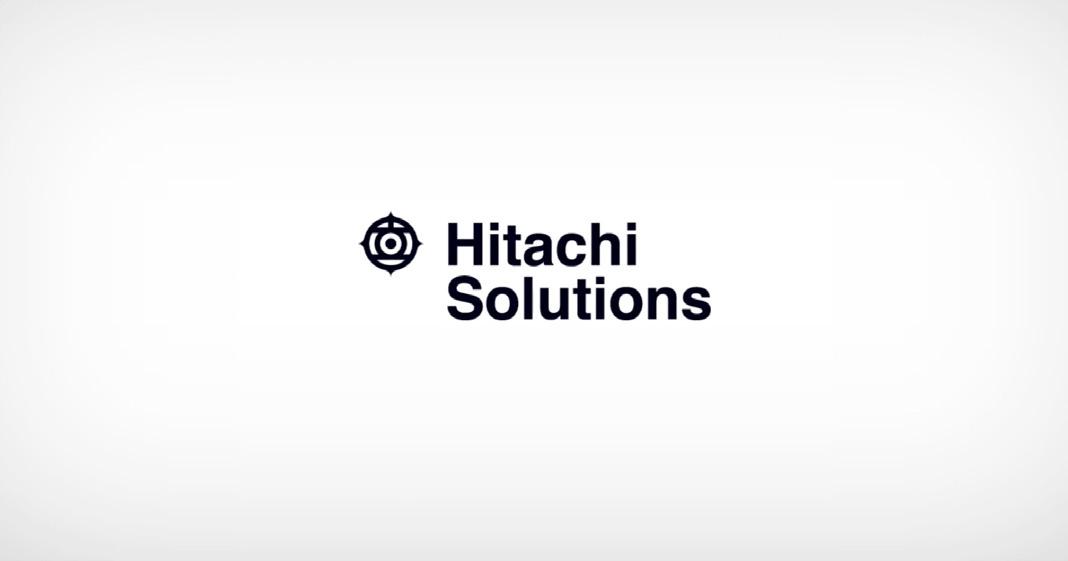
Jamie Watson, Client Director at Hitachi Solutions Europe, explains why his firm was well-equipped to assist The Royal Mint in its ambitious transformation

Embarking on its world-first Sustainable Precious Metals (SPM) programme, The Royal Mint (TRM) needed a partner that could seamlessly establish a new ERP system. The Mint joined forces with global consultancy firm Hitachi Solutions, which specialises in people-first business transformation using Microsoft technologies.
Jamie Watson, Client Director at Hitachi Solutions Europe, explains: “From a tech perspective, this involves the full suite of Dynamics 365 (D365) Business Applications: the Power Platform, Azure, and the data and AI platforms. “From a people perspective, it’s centred around change management and digital innovation.”
Detailing Hitachi Solutions’ engagement with TRM, Watson adds: “We worked very closely with The Royal Mint team to deliver a people and business-led engagement that initially focused on understanding their needs and goals. “We prioritised those needs and worked out what enabling technology was required within the Microsoft technology stack to turn those needs
into real-life outcomes. “Since then, we’ve continued our relationship, successfully tendered the SPM ERP transformation programme, and we’ve gone live with the D365 Finance and Supply Chain Management solution.”
The design and build of TRM’s new ERP solution means it will prove to be extremely sustainable in the long term. “As a collective team,” Watson continues, “we had less than six months to design, configure, test and deploy a production-ready ERP solution, which, for anyone familiar with these types of programmes, is almost unheard of.”
Watson said the project had provided “huge opportunity” for transformation across TRM’s organisation. He adds: “We can focus less on keeping the lights on and focus more on continually adding new functionality like the Power Platform, robotic process automation, and even brand-new technologies that are hitting us across AI and machine learning. “That will certainly become relevant to The Royal Mint and could, in itself, provide significant long-term benefits.”
business, so we were very quick to recognise it as an opportunity to test drive some of our assumptions and processes,” says Hobbs.
“It’s been a great learning curve for us to start on our ERP journey and, in fact, we delivered the MVP ERP within 15 weeks of inception. That was done by January and we’re already at the end of phase two, which is implementing a second phase of change.
“It’s been a really successful programme that’s had a big impact on the business.”
The pronounced importance of cloud computing to modern living, technology and the manufacturing industry is well documented. The Royal Mint’s IT transformation from on-premise to the cloud allowed for greater technological flexibility.

“Our new ERP sits on the cloud, giving us the ability to be really quick and nimble, keep it updated, and take on technology,”

“Sustainability is now at the heart of The Royal Mint – and technology plays a crucial role in this journey”
RICHARD HOBBS GROUP IT DIRECTOR, THE ROYAL MINT
says Hobbs. “But it also enables integrations to be fast and effective, allowing us to scale up the product during busy periods and to be elastic without even thinking about it.”

Moreover, cloud computing has allowed The Royal Mint to enhance its data management and cybersecurity, both of which lie at the heart of the aforementioned technology strategy. A data management function has been created to appropriately surface information to the business, which is self-serving and maintains an organised, controlled, and secure data team.
Moving to the cloud and the implementation of modern ERP across the Mint has even helped change internal perceptions of the technology department, with Hobbs adding: “We’re now seen as much more of an enabling function than a
cost function. When the business is moving fast, trying new things, and diversifying quickly, it needs the technology to do it.”
The Royal Mint has been able to count on a whole host of partners to help carry out its recent technological transformation and activities.
Its primary partner within the ERP space has been Hitachi Solutions, which worked closely with The Royal Mint’s tech team to implement the Dynamics 365 system managing the precious metals recovery site.
“We’re essentially a public sector organisation, so we have to go through a procurement process,” explains Hobbs. “When we spoke to Hitachi, from quite early on we recognised there was a really strong cultural fit.
886AD
Founded in 886 AD during the time of Alfred the Great, The Royal Mint is one of the oldest brands in Great Britain
800
The Royal Mint employs more than 800 people across functions including manufacturing and technology

Away from producing currency for the UK and other countries, The Royal Mint has successful businesses across commemorative coins and investments as well as its new luxury jewellery range
“Knowing an ERP project is potentially two or three years long, we wanted to make sure we could work together. The technology itself is quite prescribed but, on the softer side of things, Hitachi were able to engage with us and support us in our decision making.”
Also key was Hitachi Solutions’ experience in working with similar organisations and its success rate in implementing Dynamics 365. This meant that, rather than simply responding to The Royal Mint’s questions, project team members were able to add some colour to the conversations around what they’d seen before.
“We were so lucky,” Hobbs continues. “Hitachi brought in a great project team who we kept for the whole duration; they engaged with The Royal Mint side of things really effectively. It felt like they were part of our own team.

“Hitachi Solutions has been a great partner of ours for about two years now, helping to shape our story and the build we’ve just completed.”
Using Dynamics 365 and sitting within a Microsoft Azure cloud means the Mint has, of course, worked closely with Microsoft, while Optimizely provides its website platform. The emphasis from The Royal Mint’s point of view is on gathering a small but focused group of partners that help the company push through its strategy.
“We recognise that we don’t know the answers to everything,” says Hobbs. “Picking

On a mission to expand on its digital e-commerce operation, with the customer at the forefront, The Royal Mint leveraged Expleo’s domain expertise and best-in-class proprietary methods for testing and assuring technology rollouts.
Find out how Expleo can help your organisation embrace a culture of hyperautomation. LEARN MORE

As the country’s oldest company and holder of the exclusive contract to produce the nation’s coinage, The Royal Mint is an icon of British business. Expleo was offered a rare opportunity to partner with one of the country’s greatest establishments in its digital transformation.
In 2020, Richard Hobbs, Group IT Director of The Royal Mint recognised the significance of innovation within the technology function and formulated a plan to bring new technologies into the business, while accelerating time to market with new product offerings. This coupled with heightened customer expectations around seamless online experiences provided the impetus for the Royal Mint to replace legacy systems and digitalise manual processes that were tying up resources and time. The Royal Mint issued a tender for a project to digitalise its IT infrastructure, selecting Expleo to automate the testing of its e-commerce digital platforms and oversee the testing process for its switch to a new payment provider. Hobbs, architect of the
Royal Mint’s digital agenda, envisioned an ‘automation-first’ approach to IT refurbishment, geared towards expanding the company’s product suite and client base.


Top of the list of deliverables was a highperformance website – RoyalMint.com. Expleo quickly implemented a robust testing framework to identify defects within the existing IT infrastructure and put in place a quality assurance tool that has allowed The Royal Mint to develop new functionality for a smoother customer journey. This intervention dramatically reduced the number of hours required to execute a core regression test pack by 80%.
Expleo’s
Mint’s website helped the company to unlock new revenue streams across its products. Additionally, the improved testing and bug detection capabilities decreased the risk of lost sales due to system downtime, while bolstering the security of The Royal Mint’s website, and mitigating the risk of cyber-attacks.
our partners based on shared synergies and the ability to work well together is the driving factor for me.”
Another important partner for The Royal Mint is Expleo, which has grown to become a force in the fields of engineering, technology and consulting.
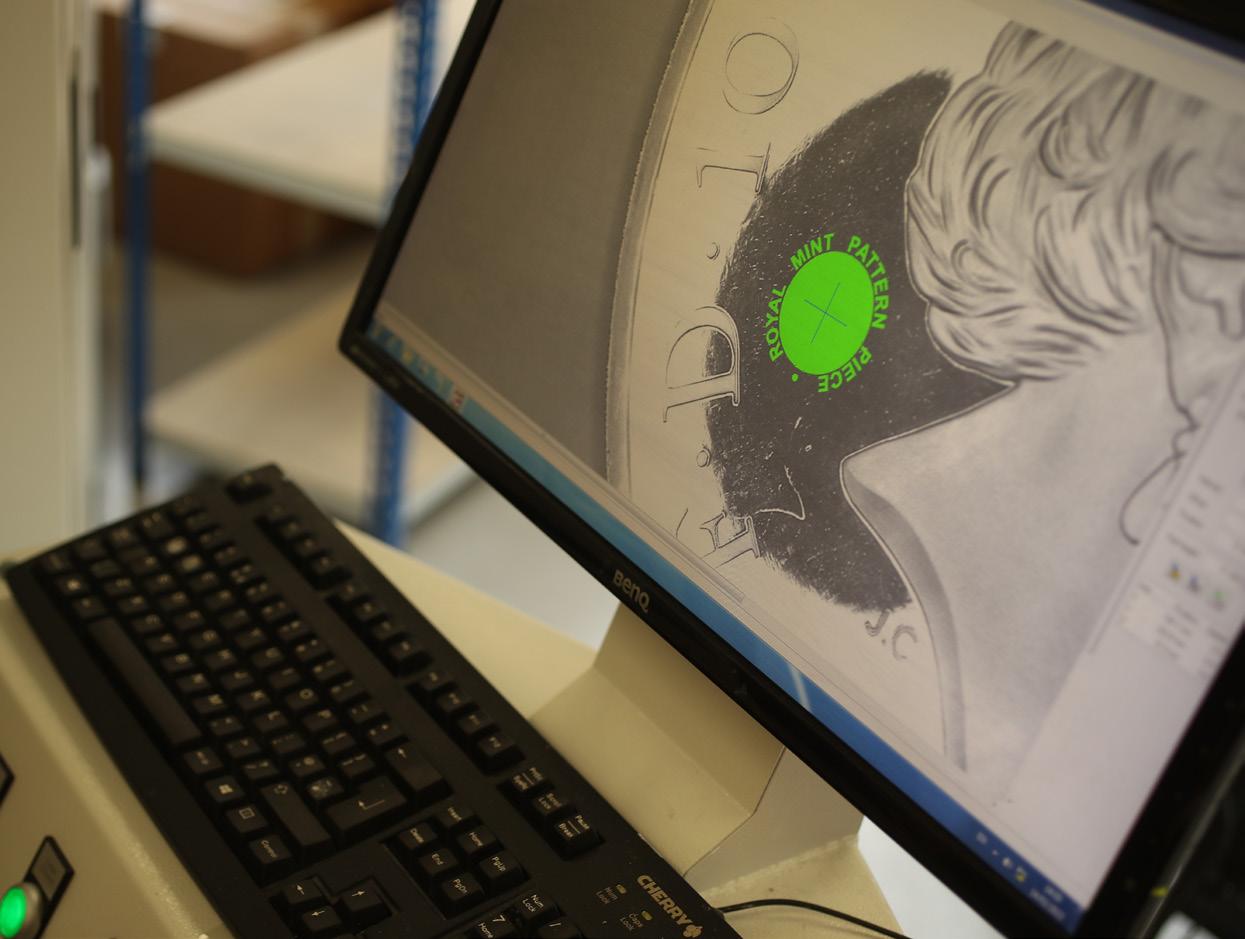
“Expleo has supported the expansion of our commercial horizons,” Hobbs says. “Their team’s technical know-how enabled us to improve our development processes and increase efficiencies across the board.
“Expleo facilitated a re-platforming of our website and oversaw the testing process for our switch to a new payments provider. Through this engagement with Expleo, we’ve been able to expedite time-
 Royal Mint Pattern
Royal Mint Pattern
to-market with a new product line, unlock viable new revenue streams and become more commercially agile.
“Overall, this phase of automation has allowed us to focus resources on more strategic initiatives, increase productivity, improve customer satisfaction and boost revenue growth.”

The Royal Mint is focused on working towards a sustainable future for its business and the environment, and this includes developing talent within the technology team.
Hobbs says: “Our technology function is robust and we want to ensure we’re sustaining as well as attracting talent to the business.”
The Group IT Director and his team have forged partnerships with the University of South Wales and the National Cyber Security Academy. They collaborate in a number of ways, including supporting students with projects and dissertations, attending speaking opportunities and sharing insights to provide students with case studies to aid their assessments.
“Hitachi Solutions has been a great partner of ours for about two years now, helping to shape our story and the build we’ve just completed”
RICHARD HOBBS GROUP IT DIRECTOR, THE ROYAL MINT
“It’s important for us as a team to engage with the local communities we operate in,” Hobbs adds. “It also allows us to demonstrate the amazing local career options that we have on offer, helping us to attract talent into the business. We work closely with educational establishments and it’s a mutually beneficial relationship; we offer our knowledge and, eventually, this may make its way back into the business via employment opportunities.”
The tech team also works with the Network 75 scheme on technical apprenticeships, allowing students to gain hands-on experience at a world-renowned organisation. The Royal Mint hires directly from university, with three technology team members being employed via this route.
“It’s important for me to ensure my team is happy, whilst delivering our technology strategy and offering a premium experience for our customers,” Hobbs continues. “Our technology function provides lots of opportunities in which our staff can fully immerse themselves, whether that’s working on our new ERP system on the cloud, data management, cybersecurity or working with our project partners.”

What next for technology at the Mint? The outlook for The Royal Mint is transformational, and its technology strategy plays a huge part in delivering some of these exciting plans.
The precious metals’ recovery site will soon go live and begin putting tonnes of e-waste to good use. Cybersecurity innovation and use of data to enhance customer experience is also on the agenda, as are various improvements to the website. It’s projected that the ERP journey will be complete in around 18 months’ time.

Furthermore, Hobbs predicts that AI and machine learning will become increasingly influential in both the technology and manufacturing spaces.
“It’s really interesting to think about how we can harness new technology like generative AI,” he adds. “What impact will it have in the manufacturing space? What can we teach it about our manufacturing processes to constantly enhance and develop them? The scope of potential innovation is boundless.”
“We work closely with educational establishments, and it’s a mutually beneficial relationship”
RICHARD HOBBS GROUP IT DIRECTOR, THE ROYAL MINT

Laura
Capper, Head of Manufacturing &

Construction at NatWest, delves into how she helps manufacturers reduce energy costs and become more sustainable
 WRITTEN BY: HELEN ADAMS
WRITTEN BY: HELEN ADAMS
Laura Capper is the Head of Manufacturing & Construction for NatWest. In her role, she leads NatWest in supporting manufacturing and construction companies through the challenges they face in the current market environment, helping them to achieve their goals and growth ambitions.
“My responsibilities include building strong relationships with industry stakeholders, as well as developing practical support and tools that address critical needs in the sector,” Capper says. “I also take a key role in developing NatWest’s sustainability strategy which helps businesses to transition to net zero and to take advantage of the many opportunities that decarbonisation of the economy will deliver.”
Having worked with SMEs and corporates in the asset finance and banking industry for 15 years, manufacturing has been a core focus of Capper’s career to date.

“In my time in the industry I have managed portfolios of customers who work within the sector and throughout the connected supply chain, driving growth and investment. I was drawn to manufacturing in part through knowing the vital role that the sector plays in supporting the future of the UK economy. This continues to evolve and, right now, manufacturers are key to developing technologies, products, and services that will help the rest of the economy decarbonise.”
While manufacturers have had to navigate seismic changes during the last few years, Capper is continually impressed by their capacity to reimagine and demonstrate resilience: “There are vast opportunities that lie ahead for manufacturing and I’m excited to help support such an innovative, multifaceted sector.”

As NatWest’s Head of Manufacturing, no two days are the same, but Capper sees that as a positive.


Manufacturing is a lucrative target for cybercrime. As a large industry with valuable data and a growing IoT attack surface, your data is of direct value to hackers.

“We currently support c50k customers across the sector, spanning from microSMEs through to large corporate institutions. We currently provide £18.1bn to support the manufacturing sector so most of my working day is spent engaging with our Relationship Managers to ensure they have the relevant sector insight and awareness to support businesses navigate the challenges they face today but, more importantly, seize the opportunities that allow them to thrive.”
Capper also works closely with external stakeholders to help drive innovation and positive change to the sector – whether that’s looking at how they collectively address the skills gap and attract future talent into the sector, or how businesses can look to save costs while also reducing their carbon footprint.

“Teams across the NatWest Group are continuously working on ways to support customers with new propositions or new products, right through to ecosystems connected to the sector, so I also spend time working with colleagues to help shape such solutions to ensure we continue to add value to the services we provide manufacturing businesses,” says Capper.
“I love how everyone across NatWest truly puts our customers at the core of everything
“My responsibilities include developing NatWest’s sustainability strategy which helps businesses to transition to net zero”
we do. Supporting businesses to thrive and achieve their ambitions is something that I feel privileged to be able to play a key part of; working for a bank who puts this as a key pillar to our purpose is what gets me excited for work each week!”

NatWest is exploring energy resilience challenges by consistently working with its network of business customers to understand the challenges they face, as well as exploring solutions and support they can provide through their relationships in the industry.
“We recently held a webinar in partnership with Octopus UK, which provided practical
advice on the key areas that manufacturers can consider to become more energy resilient. We also heard from vehicle manufacturer WN V Tech Ltd, who have already taken steps to reduce their energy consumption, which has helped them to become more sustainable in the process.”
In 2022 NatWest launched its free Carbon Planner tool, which is designed to help navigate these challenging conditions by providing a clear case for investment in sustainability through equipping businesses with greater insight into areas of high-energy and high-carbon consumption.
“With 1 in 3 business customers telling us that reduced banking fees would help them deal with ongoing pressures, we’ve launched
an EV charging cashback on Business Credit Cards to help offset the cost of doing business. This will pay between 1% and 3% cashback on credit card spend in these categories every month to businesses, from 14 February.”
Recent research from NatWest’s latest Sustainable Business Tracker shows that economic conditions are making some small to medium-sized enterprises (SMEs) hold back on their sustainability ambitions.
“A lot of this is linked to cost burdens as a result of energy market volatility,” says Capper. “The survey, conducted in December, showed that hikes in energy and material prices were especially pertinent factors for SME manufacturers, with 76% highlighting higher costs.”

“Two-thirds of manufacturers surveyed had been hit by rising energy prices, prompting 64% to invest in greener energy”
LAURA CAPPER HEAD OF MANUFACTURING & CONSTRUCTION, NATWEST GROUP



Manufacturing is one of the largest consumers of power in the UK and steep rises in energy prices have put immense strain on margins. So too has the soaring cost of materials. The sector continues to be squeezed from every angle, facing pressure to be more efficient and sustainable in a more costly environment.

“Many firms are now paying more for their energy than they would have expected a few years ago. This has squeezed margins and put pressure on cash flow,” says Capper. “Recent research we conducted across the sector revealed that two-thirds of manufacturers surveyed had been hit by rising energy prices, prompting nearly the same proportion (64%) to invest in greener energy. Nearly all have done so to make cost savings. So it’s promising to hear the sector is taking action to mitigate these challenges.”
There isn’t a one-size-fits-all answer to how manufacturers reduce their energy bills; it will depend on the individual business. According to Capper, the crucial first step towards making the best decision is information.

NatWest is committed to supporting its customers at every stage of their lives, so the work it does with SMEs to enable them to become the corporations of the future is key to the longevity of businesses across the manufacturing sector.
“Providing support via our trade finance, working capital and asset finance solutions are just some of the ways we are able to support fund businesses to achieve their sustainable ambitions,” says Capper. “Tomorrow begins today.”

 WRITTEN BY: SEAN ASHCROFT
WRITTEN BY: SEAN ASHCROFT

 PRODUCED BY: JAMES BERRY
PRODUCED BY: JAMES BERRY
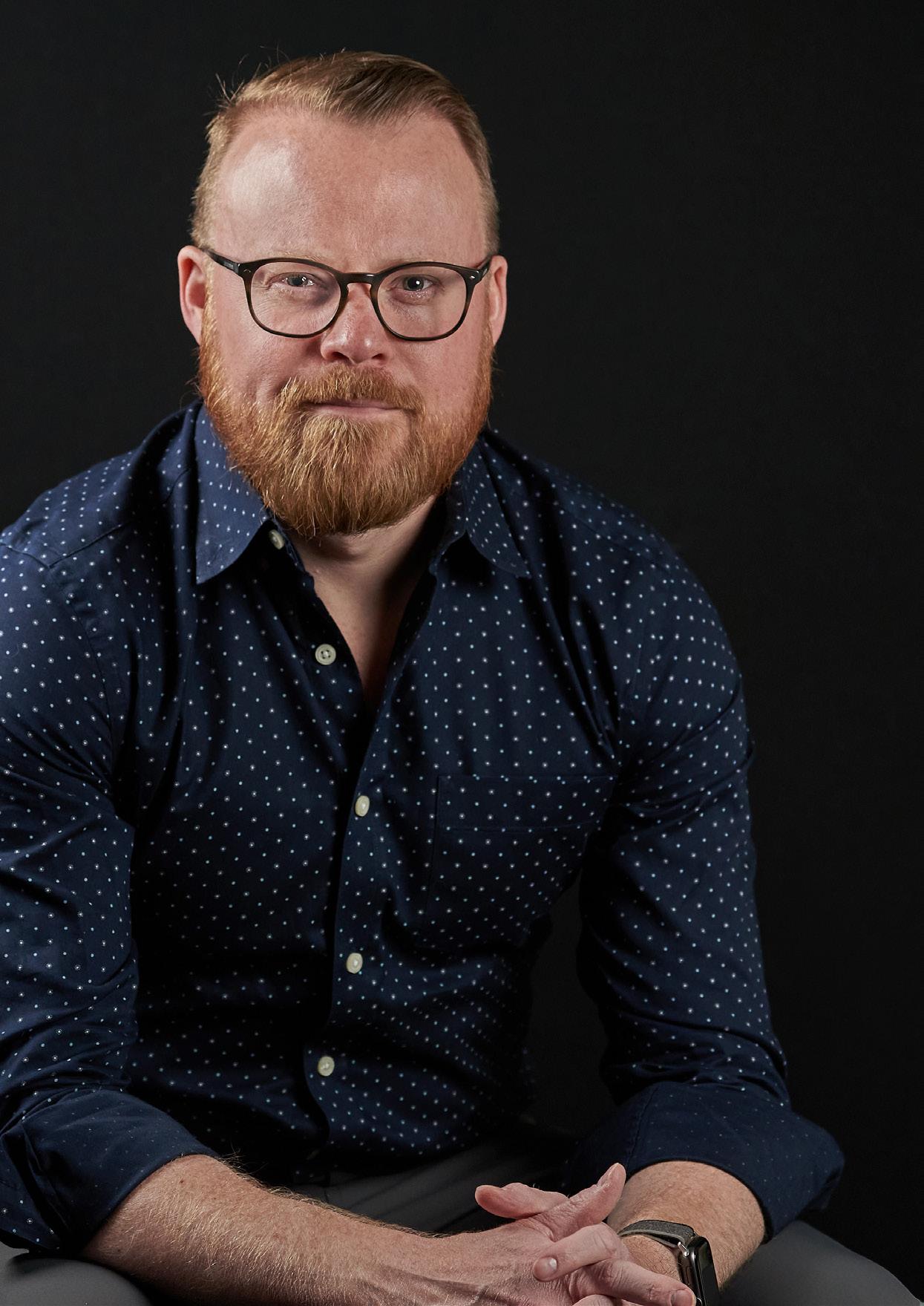



Supply chain is a complicated industry that typically requires highly trained engineers to oversee, but pharmaceutical (pharma) supply chains take complexity to another level.
As well as the usual litany of supply challenges, pharma has distinct requirements on the handling of materials like a cold chain element, and also faces the perils of product recalls and compliance issues, because the field of medicine is just about the most regulated sector there is.
And then of course there’s the added pressure of how catastrophic any delays might prove, because the medicines being shipped are critical for ensuring patients have access to the medicines they need to maintain their health, or even keep them alive.
While there is a variety of permutations, the most prevalent today is the small molecule pharma supply chain. This chemical-based drug will typically begin with the sourcing of raw materials – active pharmaceutical ingredients – used to manufacture drugs. The manufacturing process involves several stages: formulation, quality control, packaging and labelling. Once the drugs are ready, they are shipped to warehouses or distribution centres, from where they are distributed to healthcare providers, pharmacies and hospitals.





For other forms, like biologics or vaccines, the supply chain is required to keep these volatile medicines stored at the right temperature and humidity, with tracking shipments to prevent counterfeiting and diversion.


To address such challenges, pharma companies are adopting digital technologies such as cloud, blockchain, artificial intelligence and the Internet of Things (IoT) to enhance transparency, traceability and efficiency in their supply chains.
One company that is helping pharma firms digitally transform operations is Microsoft,



“My role is about being a trusted business advisor to empower our top global customers with expertise and proven practices to accelerate their digital strategy”
MIKE J. WALKER EXECUTIVE DIRECTOR GLOBAL HEALTH & LIFE SCIENCES STRATEGY, MICROSOFT
and at the forefront of its offerings is Mike J. Walker, Executive Director, Strategy, Health & Life Sciences.
In his role, Walker is the strategy leader for Microsoft’s supply chain and manufacturing point of view on pharmaceuticals, med-tech and biopharmaceuticals.

“My role is about being a trusted business advisor to empower our top global customers with expertise and proven practices to accelerate their digital strategy,” he says. “Ensuring that these conversations are business-led with a keen understanding of the pharma business along with the external market risks. As with all industries, technology is always part of that conversation, but the key is to ensure that
TITLE: EXECUTIVE DIRECTOR, GLOBAL HEALTH & LIFE SCIENCES STRATEGY

LOCATION: UNITED STATES
Mike J. Walker is an entrepreneur, futurist, digital strategist, podcast host, global keynote speaker and a best-selling author with a specialty in helping business executives stay relevant in the digital economy.
Walker brings paradigm-shifting digital transformation by leveraging leading innovation practices through experiences with Fortune 500 leaders around the globe.

He has found success in driving pragmatic approaches to large scale problems, an ability to break down large complex challenges into something manageable, along with an insatiable need to bring teams together.
Currently at Microsoft, Walker leads a team focused on life science supply chains and manufacturing.
He acts as a trusted advisor to executives, helping them with some of their toughest challenges. This includes how pharma organisations digitally transform using digital ecosystems, digital twins, AI, IoT and blockchain.


those technology conversations are focused on how strategically relevant they are to your businesses long-term goals. Once we know that, we can have a conversation on how to maximise the value potential of those technologies. That is what really matters for my client’s executive teams.”


Typically, Walker partners with “decisionmakers” – C-suiters both on the business and technical sides of pharma organisations.
The most challenging aspect of the role, he says, is “the pace and the sheer amount of change happening”. He adds: “When you peel back the onion you find each has subtly different business drivers, different cultures, different personalities and leadership styles. It requires you to employ a level of emotional intelligence to your approach. ‘This is the right answer’ is something that never flies.

Microsoft helping pharma supply chains navigate change
‘I am like a counsellor, only without the couch’
“Instead, provide the executive with a framework to work within and let them drive the conversations based on the guided journey and lots of questions. I am there to shepherd them through proven practices, almost like a counsellor, only without the couch.”
Another challenge stems from the nature of the pharma industry itself.
Walker says: “What most needs changing in pharma supply chains is the legacy mindset and a culture of risk aversion. These organisations fall into the trap of thinking they can’t do something because they’ve always done it that way. With this mindset they don’t ask the right questions.”

Questions, he says, such as: How do we create this experience within the bounds of the rules? Will the market dynamics change that would make this a viable solution? What is the level of risk tolerance we are willing to take? How can we partner with the regulatory bodies to influence change?
On the latter point, Walker says that, in his experience, regulatory bodies like the FDA are “very willing to hear you out if you've got a compelling approach to solving industry challenges”.

As for barriers to digital transformation, Walker says that here things are playing out just as they have in other sectors.
“I see lots of barriers other industries have gone through and have overcome,” he says. “It just takes time. The nice part of having a cross-industry background is I've seen how other supply chain organisations have dealt with this level of change.”

This is why Walker likes to take biopharma clients to visit Microsoft customers in other fields, such as consumer goods. He has also taken them on visits to brewing giant ABinBev Anheuser-Busch.
“Brewing beer is very similar to what a biologics organisation does,” he explains, “so showing them what is possible in a less complex environment is a worthwhile thing to do.”

Technology obsolescence is another hurdle, 65% of manufacturing environments run outdated operating systems, he says.
“Even though the intent is to update technology and software, if you’ve got manufacturing equipment running Windows XP on devices supporting your biologics


manufacturing lines, you can’t just shut it down and replace it because that could impact the entire batch worth millions of dollars.”
He adds that from a strategy perspective the challenge is “to not only fix the current problem, but to create an evergreen model that prevents obsolesce from happening to begin with”.
Of course, some of the barriers to transformation in pharma differ to other sectors, particularly around regulation. The FDA’s Drug Supply Chain Security Act (DSCSA), a single federal framework for tracing prescription medications through the supply chain, is challenging the pharmaceutical sector to reach data transaction targets by November 2023.

“We need visibility across the entire value chain, and you can't do that in a sequential, linear, compartmentalised way”
MIKE J. WALKER EXECUTIVE DIRECTOR GLOBAL HEALTH & LIFE SCIENCES STRATEGY, MICROSOFT
“There is much less scrutiny on manufacturing a beer versus a vaccine,” says Walker. “Medicine is treated very differently not only from a supply chain perspective but also from a manufacturing and a sourcing perspective.”
Pharma regulatory environment is unique
He adds: “The entire supply chain looks a little bit different, and the regulatory environment is unique. In an automotive company's supply chain, for example, they don't necessarily have to tell a regulatory body the specific specs of the machines that they will use to make that product.“
And of course, like all businesses across all sectors, pharma organisations are getting

hit from all sides. There’s a rising need to be more sustainable, materials cost more, increased energy costs – especially in Europe – which drives the impetus to do more with less cost. They're also getting hit from a geopolitical perspective, like the war in Ukraine but also, says Walker, economically from a global trade and tax perspective.
“In China for example, there is an increase in operating costs of doing business in China, especially for manufacturers with aspects like minimum wage increasing between 30% and 65% in recent years. Tax rates are also higher across the board due to a unified corporate tax, and with China’s new cybersecurity and privacy regulations, they

have the potential to transform how pharma companies conduct business in China. The most pressing question I hear from pharma executives is, should we stay or should we go.”
Walker also points out that the pharma industry is being disrupted by smaller biotech firms, along with tech-savvy companies. He likens what’s happening here to how Uber and Lyft have changed the taxi business.
“It’s the same in the pharma industry, where you've got countless small biopharmas that, from an R&D perspective, are pumping out way more patents than the traditional players.
“A lot of that has to do with their ability to be nimble and they also leverage technology at its fullest. With the bigger organisations you've got a big ship to turn, and you've got a lot of moving pieces.”
Technology is a conversation for later in the relationship
Technology is vital, but Walker says it is “always a conversation I have later in the relationship”. But it is very much a conversation that needs to be had, because many supply chains as they stand are simply ill-suited to being digitally transformed.

“Supply chains can be very linear,” he says. “The connections between the ecosystem of partners can be brittle and fragile, and there is a growing need to make sure supply chains are modular, dynamic and provide transparency across the entire value chain –and you can't do that in a sequential, linear, compartmentalised way with technology.”
He adds: “You have to do it in a way now that is much more decentralised than what it was before. There's a significant amount of processes around reconciliation of data that is introduced because of that.”

“
Many of my customers are regional ecosystem hubs that serve specific markets”
MIKE J. WALKER EXECUTIVE DIRECTOR GLOBAL HEALTH & LIFE SCIENCES STRATEGY, MICROSOFT
Walker observes that this requires “an ecosystem approach” – supported by a common “data fabric” that allows organisations to digitise their supply chains in a meaningful way.
On this note, Walker has partnered with Kinaxis, a ‘visionary leader in supply chain’ solutions, according to analyst firm, Gartner.
Walker believes that leveraging the power of the Microsoft Azure cloud platform together with Kinaxis' solutions will provide pharma organisations with an agile and autonomous supply chain platform,

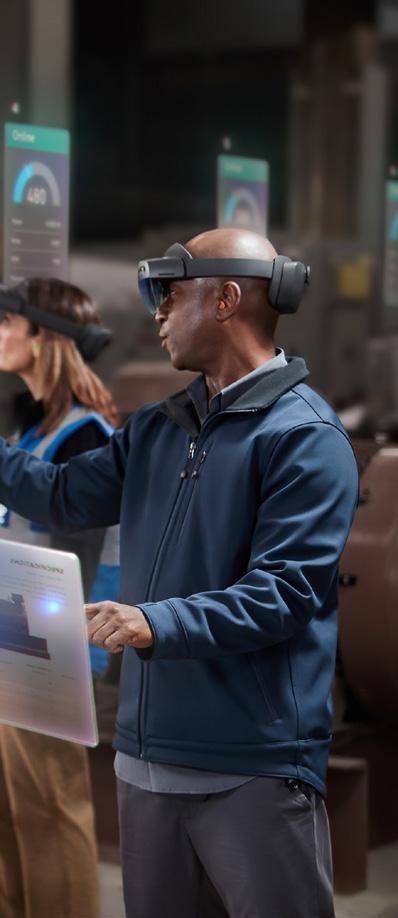
which are essential in today's rapidly changing business environment.


He says: “This combination of capabilities enables a digital ecosystem platform for pharma supply chains that uses advanced analytics and artificial intelligence to analyse data from across the supply chain, including suppliers, customers, and internal systems.
“It can also integrate with other systems, such as ERPs, MES, CRMs, and logistics systems, to provide a comprehensive view of the entire supply chain.


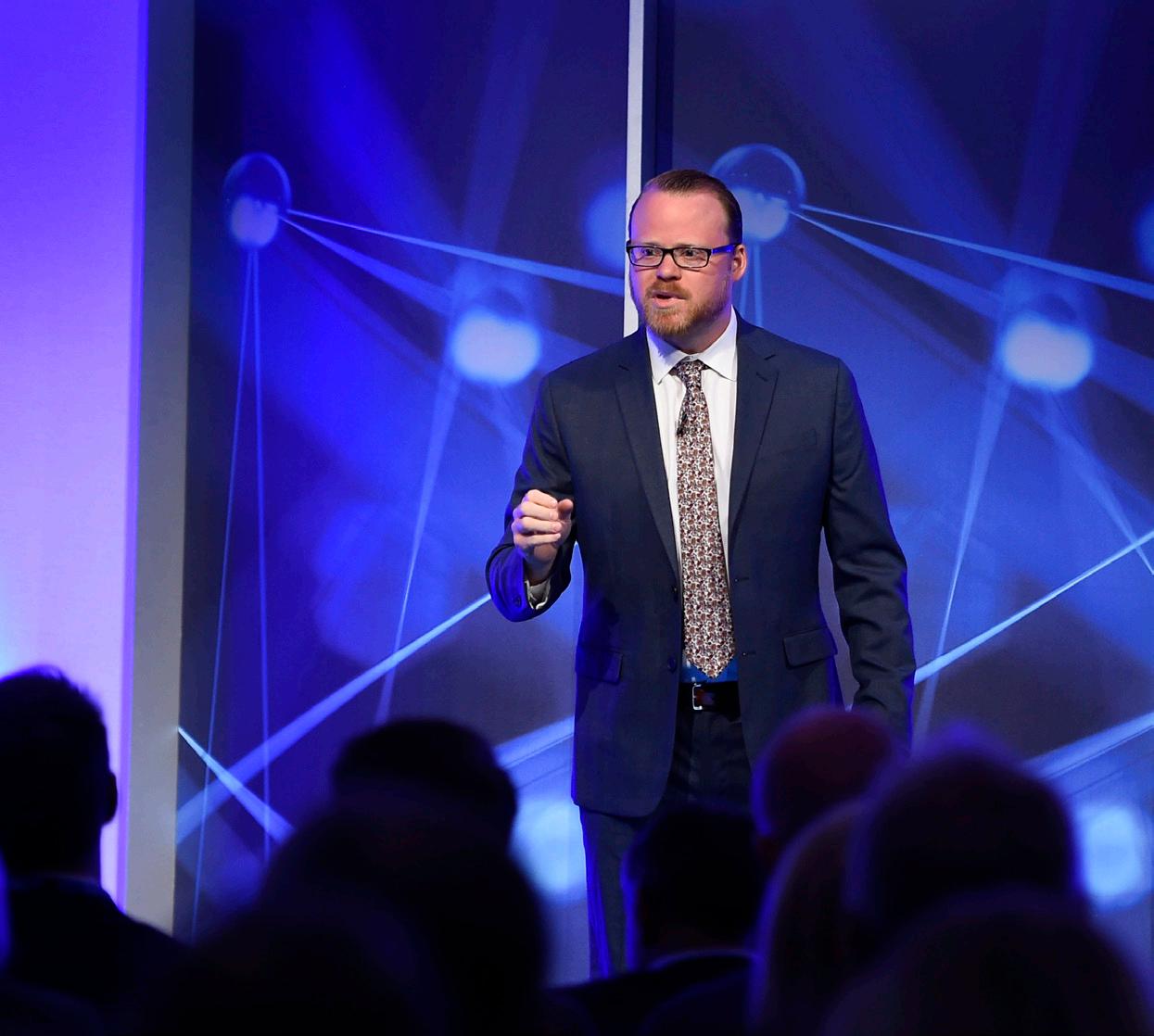


Walker recounts a past conversation he had with a pharma company.
“They were talking about how one of their key priorities is to digitise all instances of paper use,” he says. “On the surface
“But I asked if this meant putting scanners into their factories at each process-step to make sure that all paper was scanned, and then entered into a document management system.
“Then I asked if they wanted instead to solve the root problem, which was fundamentally how to reinvent the business process and how data is handled.” This, he says, requires a rethink of the organisations’ relationship with data

Walker says he knows of pharma organisations that are leveraging digital twins for an end-to-end view of their supply chain. But does this tick all the boxes that need to be ticked, even? Probably not, he feels.
“When you look at these digital twins there's different levels and types. You have layers of digital twins that coexist within an organisation. Some represent the asset itself. Some represent the people and the interaction. Some represent the process, and others represent the facility or the
Walker says that what is needed, and often lacking, is a strategy around creating “a common data platform that is able to create digital threads to connect all of this data”, and “a full genealogy of everything that was involved in the creation of all these layers of digital twins”.
What makes Microsoft unique is our commitment to industry specific standards

and communities, such as the Open Manufacturing Platform, the OPC Foundation, the Digital Twins Consortium and our innovative partner ecosystem, coupled with composable and extensible solutions that seamlessly connect people, assets, workflows and businesses processes. Our technology is giving businesses more intelligence and visibility than ever before and making operations more adaptable.
Looking at the bigger geopolitical picture, Walker says pharma companies are changing the shape of their businesses, by stepping away from globalisation.
“I've heard from four very senior executives in the pharma supply chain that globalisation as an approach is dead,” he says. “Now it's more about de-globalisation and modularity. Many of my customers are creating an ecosystem of ecosystems strategy whereby they are regional ecosystem hubs that serve specific markets. However, each one of these is still loosely connected and provides a level of autonomy but also flexibility.”
Walker references McDonalds here because “they solved this problem in the fifties with the franchise model”.

He adds: “Why make every one of your factories unique and bespoke when you can create a franchise model that provides speed, modularity, and flexibility through a common set of methods and standards? For example, maybe it would be possible to take an oral solid dose drug and make the manufacturing and supply chain 90% standard across all applicable factories.
“This also gives you a level of nimbleness and agility in the marketplace that you won't have in linear supply chains with bespoke factories.”

QAD Redzone’s Lance Olmstead returned to civilian life after years of service. He’s since landed in manufacturing & wants more veterans to join the sector
WRITTEN BY: HELEN ADAMSAccording to the 2021 census, there are 16.5mn veterans in the USA – totalling 6.4% of the adult population. Lance Olmstead served as a noncommissioned rifleman in the United States’ Marine Corps from 2002-2010, and he’d recommend it to anyone debating whether or not they should join the service.
“Once I exited the line of active duty and returned to civilian life, I gained a unique perspective of the world around me, especially the civilian workforce,” he says.
Olmstead realised that many skills he gained throughout his time in active service could be applied to the civilian world, such as integrity and strategy-based leadership, which gave him a leg up against his peers in the business world.
Now Olmstead serves as the SVP of Enterprise Sales & Head of EMEA at QAD Redzone, where he spends his time supporting his fellow veterans back into civilian life and encouraging businesses to employ them.
“I first joined Redzone in its formative years as a Continuous Improvement Coach, a hands-on practitioner position recruited to implement QAD Redzone’s 90-day resultsdriven frontline coaching programme,” said Olmstead. “My background in organisational leadership was refined through my tenure in the United States’ Marine Corps. This has ensured our product and coaching model work together to deliver productivity improvements and a culture change, both of which are the hallmarks of using QAD Redzone.”
Software development company QAD Redzone was founded in 2013 and is based in Miami, Florida. Over 1000 manufacturing plants use their technology.




6 - 7 September 2023
Business Design Centre, London
SPONSORSHIPS GET YOUR PASS
“Our cloud-based Connected Frontline Workforce (CFW) application drives rapid, tangible increases in plant productivity and employee retention,” says Olmstead. “Our coaching team integrates with customer plants for 90 days to help them master the QAD Redzone solution and trains every worker in the ways they can best use these tools to improve their day-to-day operations.”


The aim at QAD Redzone is to give more autonomy and authority to frontline manufacturing workers by streamlining and revamping the way they interact with their colleagues and management.

When Olmstead returned to the civilian workforce, it became clear to him that there were several misconceptions regarding the relevant skills of active-duty members and veterans.
“It became imperative to articulate my skill set in the most effective way possible to reflect the high level of professionalism and efficacy I – and other service members – obtained from the military,” he explains.
“Recognise that you’re very different and then lean into the differences rather than trying to fit into the mould”
LANCE OLMSTEAD SVP OF ENTERPRISE SALES & HEAD OF EMEA, QAD REDZONE


Most challenges veterans face when re-entering the workforce begin with the misconceptions employers have about veterans’ skill sets, making it difficult to clearly articulate what these individuals accomplished and how they can support the civilian workforce.
“Active duty members have highlydeveloped skills the business industry looks for in top candidates – such as leadership skills built on integrity and strategic thinking – but, at times, it can be difficult for veterans to articulate how those skills were developed through active duty work,”
Olmstead continues. “There is an added pressure to accurately display these skills to achieve a job that equally matches their own abilities.”
Another challenge some veterans face is a lack of intensity in the average workplace.
“Most veterans feel an intense change of pace when they re-enter the civilian workforce, as their new occupation is drastically different from being in the line of duty,” explains Olmstead, who firmly believes that the manufacturing sector is one of the best-emerging industries for transitioning veterans.
“Manufacturing has a clear objective and mission,” he says. “You either hit that objective or you don’t. It’s a very black-and-white field, very similar to the military. A person that has been on active duty can thrive in an environment like manufacturing because they are able to move their team toward an objective – or a victory. In other industries, goals aren’t as clear cut, but in manufacturing, everything is set up naturally to work in team environments, where everyone is working to support one objective.”

“Active duty members have highly-developed skills the business industry looks for, like leadership, built on integrity and strategic thinking”
LANCE OLMSTEAD SVP OF ENTERPRISE SALES & HEAD OF EMEA, QAD REDZONE

“I would advise businesses hesitant to employ a veteran to meet with a few veterans to discuss their skills”
LANCE OLMSTEAD SVP OF ENTERPRISE SALES & HEAD OF EMEA, QAD REDZONE

“For many veterans, career progression is the main focus for life following active service,” says Olmstead.
To best support this population, the manufacturing industry can look inwardly to see how they can create merit-based promotion paths that prioritise milestones and accomplishments rather than tenure or seniority.
“Creating a new purpose for former military service members will set manufacturing apart from other industries,” he says.
While many businesses are keen to outwardly support the troops, some can be hesitant to employ a veteran. From his own personal experience, Olmstead knows that some employers still believe in the outdated stereotypes surrounding veterans from nearly 80 years ago.
“Veterans today are eager to enter the workforce and reapply the skills they have learned from their time in active duty to civilian life. I would advise them to simply meet with a few veterans to discuss their skills,” he says. “More than likely, these employers will see there’s more crossover between the two paths than they realise.”
To the veterans who have returned from active duty and are looking for a job, Olmstead would encourage them to pursue a career in manufacturing. After all, out of the Fortune 500 companies, 163 CEOs are ex-Marines.
“The head of NASA is a Marine. The former CEO of Bank of America was a Marine. The founder of FedEx was a Marine,” Olmstead highlights. “The biggest thing is differentiating yourself from the competition when you move into a new role. The Marine Corps has a proven track record of success in the civilian sector. Recognise that you’re very different and then lean into the differences rather than trying to fit into the mould.”




 WRITTEN BY: HELEN ADAMS
PRODUCED BY: GLEN WHITE
WRITTEN BY: HELEN ADAMS
PRODUCED BY: GLEN WHITE



Healthy plants, pottery, and sustainable growth are some of Courtney Holm’s core interests. As the Vice President for Sustainable Futures at Capgemini Invent, her role can sometimes touch on all three.
Capgemini Invent is an arm of the Capgemini Group that focuses on digital innovation, consulting, and transformation. Holm’s role is to align sustainable development to client strategy and to help them embed cross-sector collaboration as a core competence.
Holm has lived in England for 13 years and is currently based in West Sussex, where she works from home a few days a week with quite a view. “We wanted to be closer to the forest and the coast. It’s the right place for us at this point in our lives,” she shares.
Holm has always been interested in sustainability and started her career back in the 1990s studying environmental science. “I then moved on to literature, pottery, and sociology, because I wanted to understand and write about how human disconnection and distraction away from nature was the root cause of all of our environmental degradation and social issues.”
During her literature degree, Holm focused on Shakespeare, believing no one else understood the human condition like him. Sociology to study society and human interactions, and finally pottery as one of the first human expressions from Earth’s bounty.

Capgemini Invent supports other companies to become more sustainable; Courtney Holm, Vice President for Sustainable Futures, tells us more

“Lo and behold, I couldn't get a job,” Holm admits. “So, I started working in horticulture, studied it formally, earned a certificate and then continued working in nursery and greenhouse production.”
This was in 2000 and was Holm’s first commercial encounter with technology and software for production management. “Technology was just starting to evolve, especially in the agriculture and horticultural space. By the end of it, I was managing quite a lot of the greenhouses and the fields from a rudimentary smartphone.”
After taking a year long break to travel, Holm moved to the UK to complete an MBA as she wanted to gain a broader understanding of corporate thinking around sustainable development. As such, she joined 2degrees – at the time, the world’s largest online community of sustainability practitioners – where under the direction

“As a society, we've been too focused on resiliency; we need to pivot towards adaptation”
COURTNEY HOLM
VICE PRESIDENT FOR SUSTAINABLE FUTURES, CAPGEMINI INVENT
of Martin Chilcott, she learned the importance of cross-sector collaboration and implemented it as the client director for the Tesco business at the company.

“I helped Tesco transform its fresh-food supply chain through the Tesco Producer Network and helped them launch their agricultural policy, through onboarding their global producers onto an online community to facilitate cross category collaboration. We also created the Tesco Knowledge Hub, with the remit to reduce the carbon footprint within its tier-one supply chain and support resource efficiency through cross-sector collaboration.”
After 2degrees, Holm moved onto a global role with Unilever where she focused on raw
TITLE: VICE PRESIDENT FOR SUSTAINABLE FUTURES
COMPANY: CAPGEMINI INVENT
INDUSTRY: BUSINESS CONSULTING

LOCATION: LONDON, UK
Courtney Holm is Vice President of Sustainable Futures at Capgemini Invent. Her role is to shape the way Capgemini creates long term, sustainable value for clients, enabling them with fresh perspectives and digital solutions so that they can play a transformative role in addressing planetary, people and systems challenges. Courtney has a proven track record of implementing innovative technology solutions across sectors; helping clients with a broad range of strategic and operational sustainability challenges. She is an expert


Anna Mazzone is the EMEA Vice President for ServiceNow’s risk and ESG business unit, which provides a full suite of applications for clients to ensure they comply with ESG regulations and their governance, risk management, and compliance policies for running their organisations.
“ServiceNow delivers a company’s digital enterprise backbone that enables employees to take action in business today,” explains Mazzone.

“We make it easier for employees to make decisions. We aggregate data across similar assets so that they can understand how those assets are performing in real-time across the organisation.”
As a company, ServiceNow is on a journey to do its part in improving the environment.
“We believe that ESG, like risk mitigation and DEI, is everyone’s job across the organisation,” says Mazzone. “We’ve made very ambitious commitments; we have science-based targets that are helping to support our journey towards realising netzero, in terms of carbon emissions by 2030.”
With our dedicated team, we have reduced carbon intensity by over 50%, and now using 100% renewable electricity in facilities.
The partnership between ServiceNow and Capgemini is one of deep trust and respect. “They’re one of our global partners,” says Mazzone. “One of our most highly-regarded partners, as well. We’re both very much aligned to deliver solutions that are really focused on enabling our mutual clients to deliver a sustainable work environment.”
Our partnership with Capgemini works to deliver in three ways:
• Working together to ensure clients can deliver more secure technology environments by, for example, mitigating cyber attacks
• Improving employee work-life balance with truly outstanding digital experiences
• Focusing on faster resolution of client problems and queries by designing highly -efficient processes for mutual customers

material traceability and was later promoted to Global Head of Sustainable Technology, where she helped colleagues leverage technology to deliver and scale the Unilever Sustainable Living Plan.

During her time in the UK, she learned that no one organisation could solve a systemic issue, and that multi-lateral collaboration was the only path towards a more sustainable future. In order to scale her impact, Holm understood that she needed to work with clients across different sectors, capabilities, and regions – which is why she decided to go to a consulting business. She joined Capgemini Invent in the UK, as Capgemini was expanding its client-facing sustainability offerings, which appealed to Holm.
“I wanted to influence and shape a capability – I'm entrepreneurial – and I have been afforded that luxury,” she explains.
“Even if we were to reach net zero tomorrow, alreadyexisting climate issues and their effects wouldn’t change. We don't know for sure what temperature we'll land on yet”
COURTNEY HOLM VICE PRESIDENT FOR SUSTAINABLE FUTURES, CAPGEMINI INVENT
“I've been here for nearly two years, and, in that time, I've established a practitioner-led capability and worked on embedding what I like to call ‘sustainable by default’ ways of working into the business and our services.

“To differentiate Capgemini Invent from other consulting firms, I've grown a team of experts and specialists – we've created a network of 550 consulting colleagues. In 2021, we collaborated with the University of Exeter and its internationally renowned climate scientists and sustainability experts to create a bespoke training programme for our consulting organisation, called the ‘Capgemini Invent Sustainability Solutions Leadership Development Programme’. The programme reinforces our wider team’s knowledge on global sustainability issues, ensuring they can bring value to our clients.

“Capgemini Invent is getting recognised in the market for having a different approach to other consulting firms”
Capgemini Invent helps companies hit their sustainable goals
COURTNEY HOLM VICE PRESIDENT FOR SUSTAINABLE FUTURES, CAPGEMINI INVENT
“Those who have completed this programme utilise their education while working side by side with our sustainability experts, enabling them to become practitioners in their own right over time.”
Helping companies become more sustainable
Capgemini Invent helps companies become more sustainable. “Capgemini Invent sits inside a wider organisation that’s a global leader in partnering with companies to transform and manage their business by harnessing the power of technology.
“From a sector perspective, Capgemini Invent assists both the private and public sector – including financial services, manufacturing, automotive, and life sciences, in addition to energy and utilities,

consumer products, telecommunications, and technology services.”
The brand also offers other capability units, including ‘Customer First’ which helps clients to deliver exceptional personalised experiences and continuously reinvent their businesses and offerings. “We have an ‘Intelligent Industry’ division, where we harness the potential of technology and data to transform and digitise products, industrial operations, and connected services across industries. And there’s ‘Enterprise Management’, where we help deliver, transform, and manage operations for digital core, business processes, and enterprise applications for greater agility and operational efficiency.”
Capgemini Invent has a further focus on business technology, including architecture
and IT as a service, factories, and acceleration. There's also a focus on analytics and artificial intelligence. Holm is a big fan of technology as an enabler for sustainable growth and, at Capgemini Invent, the team work to find digital solutions to help tackle environmental and social challenges.
Capgemini’s sustainability framework Capgemini is committed to helping clients with their climate and social transitions and has built a sustainability framework that focuses on three guiding principles for change:

• Commit
• Act
• Monitor and Report
“This is how we help our clients commit to sustainability for their core business, so that could be around their net-zero strategy, for example. Then we have a layer around taking action, so how do we help them to navigate the appropriate course of action to uphold commitments and drive change. For example, this could be by bringing sustainable products and services to the market or by optimising operations or IT to be more sustainable.”
The Monitor and Report pillar is concerned with data, and how the company helps its customers ensure that governance is structured to drive business change and facilitate reporting that’s consistent and coherent. For Holm, capturing and using the right data is fundamental to delivering change programmes: “It ensures that clients are getting the most out of the change, monetising the data that they're capturing in the best way possible, and that there's excellent datadriven decision-making.”
“We have the ambition to accelerate change and help create a sustainable and inclusive future. We want to be the consulting practice that helps clients be doers and not delayers, to put their assets to work towards the transition of the economy and climate change adaptation. Our guiding principles are critical to help us and our clients to prioritise scalable solutions, and to prepare for and adapt for the future.
“We have a broad range of specialisms across the team and can support clients with decarbonisation and efficiency, sustainable and responsible procurement, biodiversity strategy and implementation, sustainable consumption, product design and life cycle assessments, KPIs and reporting technology decisions, and with their brand purpose.”

The reception to this approach among Capgemini Invent’s clients has been positive with many surprised and delighted by its breadth and depth. “We're getting recognised in the market for being expert led and for having a different approach to other consulting firms,” shares Holm.
Client-centred sustainability strategy & collaboration
Capgemini has partnered with ServiceNow to build its domain and advance its digital excellence journey, ensuring greater flexibility and efficiency across the Capgemini ecosystem, in addition to the accountability of a single-source provider model.

For Capgemini Invent, it's about how to support clients advance their thinking

around sustainability. “We work with some great brands. How do we best support them on their sustainability journeys? A big key to my strategy – as I mentioned earlier – is cross-sector collaboration.”

“Capgemini is not a software firm, so technology partners are important so that we can provide technical solutions to clients. We are also technology agnostic, putting client business requirements ahead of any one solution that one of our partners may have. ServiceNow is a great partner because they also take a platform approach that works across multiple technology solutions, to manage digital work flows and ESG data from across an organisation’s systems,” explains Holm.
This year, Capgemini Invent is hosting a number of intimate events around
“We have the ambition to accelerate change and help create a sustainable and inclusive future. We want to help clients put their assets to work towards the transition of the economy and climate change adaptation”
COURTNEY HOLM VICE PRESIDENT FOR SUSTAINABLE FUTURES, CAPGEMINI INVENT

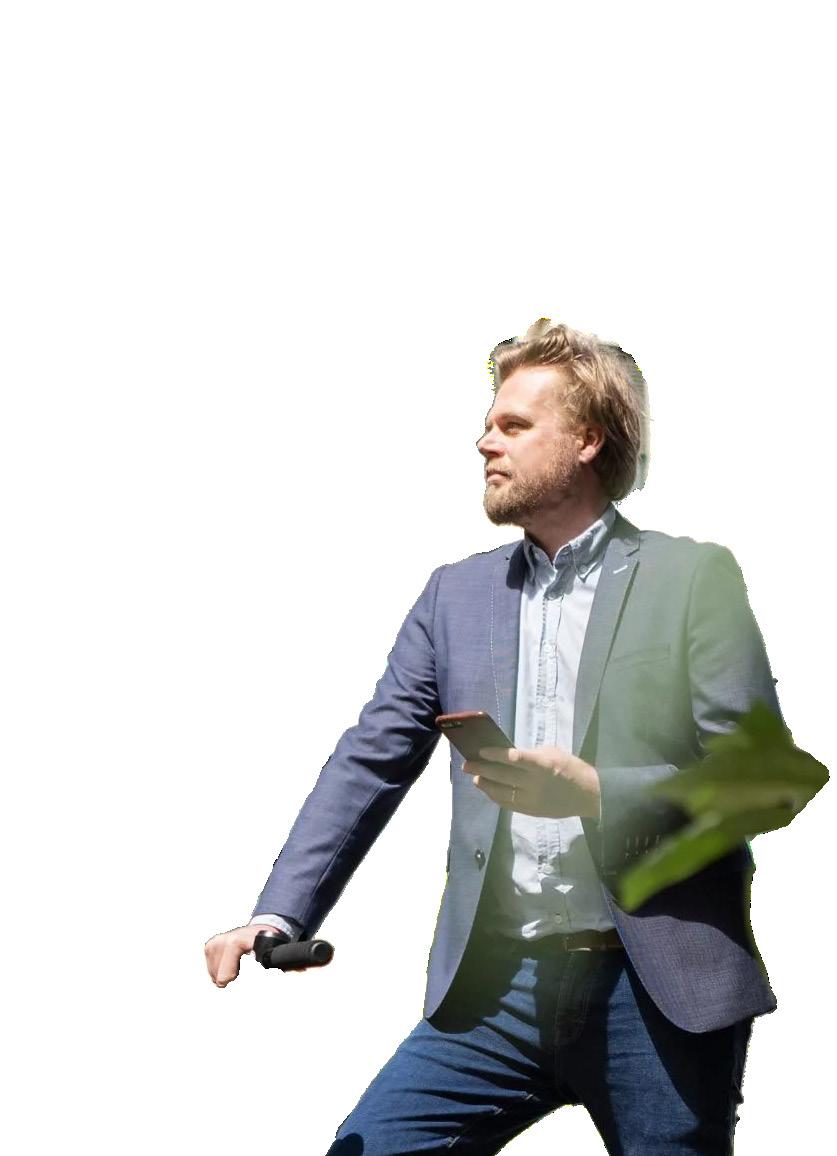
key topics that require cross-sector and multilateral collaboration. These events will dive deep into lesser-discussed issues surrounding specific topics that go beyond net-zero and carbon-mitigation strategies. “Biodiversity and community engagement around water basins is one of those topics. Another topic that we’re exploring more will be decarbonisation of UK homes.”
It is all go at Capgemini Invent, then – but Holm believes that it’s going to take every


business to put sustainable structure in place. “I really do worry that we’re not ready for the changes global warming will bring,” says Holm. “There’s so much that we have to change – not only about how businesses are run, but also how we live personally –and I think we’re currently unprepared for those changes.”
That’s why one of Holm’s key objectives is the focus on adaptation strategies. “We want to help our clients to see sustainability as an opportunity to build long-term value and a source of competitive advantage, not just a compliance requirement. This means shifting the focus from risk-avoidance to promoting justice and regeneration.”
Practically, this means supporting clients with an investment roadmap, with causality linked to their Capex and Opex expenditures, helping them understand the secondary and tertiary impacts of their investments over time, prompting them to take a long view. This will allow for customers to reduce impact, improve social wellbeing, and be more prepared for some of these changes.
“As a society, we've been too focused on resiliency,” says Holm. “Now, we need to start to shift towards adaptation, because even if we were to reach net zero tomorrow, already-existing climate issues and their effects wouldn’t change. We don't know for sure what temperature we'll land on yet.”
In the face of irreversible climate changes Holm believes that the industry needs to prepare for more change, mitigate any further climate impacts, and advise companies on their next steps – the latter of which function as Holm’s next steps for Capgemini Invent.
Our Top 10 sustainable manufacturers are Unilever, Nestlé, BMW, Peugeot, Vestas, Patagonia, Dassault Systèmes, Arçelik, Stella McCartney & Schnitzer Steel
 WRITTEN BY: CHARLIE KING
WRITTEN BY: CHARLIE KING
The Paris Agreement calls for a 1.5°C cap on global warming. To achieve this, emissions need to be reduced by 45% by 2030 and reach net zero by 2050 according to the United Nation’s Net Zero Coalition.
“Today’s consumer asks even more than before for sustainability. They want to know that we are treating the planet well, they want to know we’re taking
care of the next generation,” says Nestlé CEO Mark Schneider.
We’ve compiled our Top 10 Sustainable Manufacturers from industries including transport, food and beverage, fashion, and more, taking a deep dive into sustainability plans from some of the top performers in manufacturing working to achieve these global goals while remaining at the top of their fields.
BMW Group’s virtual factory planning tool integrates various planning data and applications and enables real-time collaboration without compatibility limits
 IMAGE: BMW
IMAGE: BMW
10

Schnitzer Steel 10
Portland-based sustainabilityaward-winning Schnitzer Steel is heading to a low-carbon future – in 2022, it recycled more than 5mn metric tonnes of metals, which avoided approximately 5.5mn metric tonnes of CO2e emissions, and maintained 100% net carbon-free electricity use across operations.
Schnitzer Steel has recently launched GRN Steel, a line of net-zero carbon emissions steel products and sold 465,000 short tonnes of finished steel products made from recycled ferrous metals in 2022, as reported in the company’s 2022 Sustainability Report.


International fashion brand Stella McCartney has been known for its vegetarian choices since it was founded in 2001. It famously boycotts materials including leather, feathers, and fur, in favour of alternatives it created from sustainable alternatives including grape waste and recycled industrial materials.
In 2021, it was the only brand from the fashion industry to attend COP26; more recently, in 2023, the brand released its first garment designed to be returned and regenerated into new yarn at its end of life.
08 07
Turkish electronics manufacturer Arçelik has had a sustainable focus since it was founded in 1955 with the mission: ‘Respects the Globe, Respected Globally’. The company is committed to reach net-zero emissions in the value chain by 2050.

“If we wish to ensure a sustainable future, we must learn to act together,” says CEO Hakan Bulgurlu – discussing Arçelik’s role as an early adopter within the United Nations Global Compact and its commitment to the Race to Zero campaign.

Dassault Systèmes is a sustainability-focused technology company that provides collaborative virtual environments in which to imagine sustainable innovations.


It commits to achieving climate neutrality by 2040 and has been ranked by Corporate Knights in the 2021 Top 100 Most Sustainable Corporations in the World.
08 07 manufacturingdigital.com 149


Since 1985, Patagonia has pledged 1% of sales and contributed over US$100mn in grants to the preservation and restoration of the natural environment.
Internally, Patagonia’s Supply Chain Environmental Responsibility Program measures, reduces and eliminates environmental impacts of manufacturing throughout suppliers and manufacturing. Successes include:

• 98% of the line uses recycled materials
• 86% of the products in the line are Fair Trade Certified
• In 2020, Patagonia repaired over 100,000 garments
• Patagonia has kept 935 tonnes of plastic waste from the oceans by recycling discarded fishing nets.

Danish wind turbine manufacturer Vestas is a global leader in sustainable energy solutions. Recently ranked the second most sustainable company in the world by The Corporate Knights Index, its sustainability promises include becoming carbon neutral – without using carbon offsets – by 2030 and producing zerowaste wind turbines by 2040.
Vestas are also global energy pioneers: during the pilot programme of the first hydrogen-powered offshore service vessel in the world, Vestas saved 9.3 tonnes compared to a traditional vessel.
Vehicle manufacturers Peugeot believe that sustainability is a responsibility in every part of the product’s lifecycle.

In production, vehicles are made up of an average 30% green materials. During use, they are designed to be environmentally friendly and the company is continuously developing clean technologies. Once the cars are off the road, Peugeot’s end-of-life recycling scheme – for vehicles of all makes – aims to achieve a 95% recovery rate, with at least 85% reuse of parts and recycling of materials.
BMW
German vehicle manufacturers BMW are pioneers in sustainable vehicle development down to every detail.
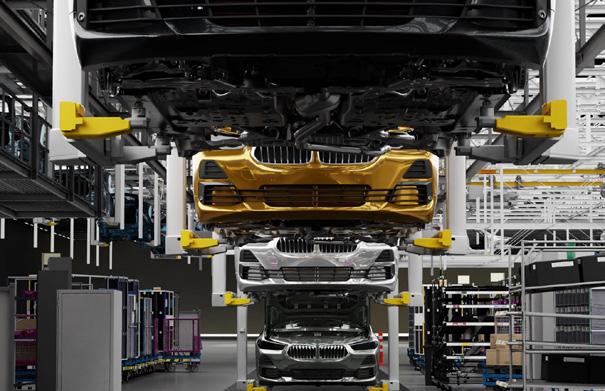
With no methane gas production, no waste tannery water, huge saving on CO2, and faux-leather seats – made out of recycled cactus – are within the luxury brand’s standard for sustainability and comfort.
Oliver Zipse, Chairman of the Board of Management, says:
“Sustainability and economic success go hand in hand at the BMW Group. As a premium manufacturer, we have the ambition to lead the way in the area of sustainability.”

As the world’s largest food and beverage company, Nestlé believes in the power of food to enhance quality of life for everyone – today and for generations to come.

Among other goals, it aims to:
• Halve greenhouse gas emissions by 2030 and achieve net zero by 2050
• Use 100% deforestation-free primary supply chains for key ingredients by 2025
• Reduce water use in factories by 6mn m3 between 2021 and 2023
• Source 20% of key ingredients through regenerative agriculture methods by 2025 and 50% by 2030
• Design over 95% of plastic packaging for recycling by 2025, and continue to work toward 100% being recyclable or reusable
“The younger, the better educated, and the wealthier the consumer, the more interested they are in environmentally-sound products and practices,” says Nestlé CEO Mark Schneider, discussing financing sustainable practices. “These days, there’s total transparency about your supply chain, so people do understand what you’re doing for the planet, and they reward the companies that are leading this trend.”






Unilever's focus on sustainability covers its products, supply chain, partners, and global governance –and, with a staggering 3.4bn people globally using Unilever’s 400-plus brand names every day, the impact that such brand corporations can have is crucial.

Unilever is pushing towards zero emissions in its operations by 2030, and net zero emissions across its value chain by 2039, alongside finding new low-carbon ingredients, expanding its plant-based product
range and developing fossil-fuel-free cleaning and laundry products.
“Our view is if we want to be a relevant business for decades and centuries to come, we better address the wishes and needs of young consumers. And for sure, sustainability is at the heart of their brand choices,” says Alan Jope, CEO. “I think ten years ago we did not fully understand the business case for sustainability, and now we do. Ultimately, there is no sustainable Unilever without a sustainable planet.”
 WRITTEN BY: SEAN ASHCROFT
PRODUCED BY: JAMES BERRY
WRITTEN BY: SEAN ASHCROFT
PRODUCED BY: JAMES BERRY

Helping to spearhead digital transformation programs across the process industry is no small feat, but Microsoft’s industry executive Yury Gomez is the perfect fit for the job.
Gomez – Global Chief Commercial Leader for Process Industries – has a supply chain background, which means that not only is she battle-hardened, but she also has a real-world understanding of what works and what doesn’t when it comes to manufacturing operations.

She has also been tempered by the seismic experience of COVID-19: “Supply chains have always existed. It’s always been the job of demand planners, forecasters, financial planners, and supply chain leaders to make sure products are at hand, and to take care of inventory control, product delivery, and customer satisfaction. But then COVID19 came along and, overnight, none of this worked any more. That was challenging, and I was thrilled to be on my mission to help customers overcome that challenge.”
Gomez began her Microsoft career as Global Executive Director for Pharmaceutical & Life Sciences Manufacturing and Supply Chain Digital Transformation, and had the opportunity to accelerate digital transformations during COVID-19 – a time, she says, “when customers looked to technology companies to help them overcome their supply chain challenges”.
Yury Gomez – Microsoft’s Process Industries lead – explains why the company’s tech ecosystem is driving change

Now, she leads digital transformation for all process industries – including the chemicals industry, specialty chemicals, pulp and paper, steel, pharmaceuticals, and the consumer packaged goods space.
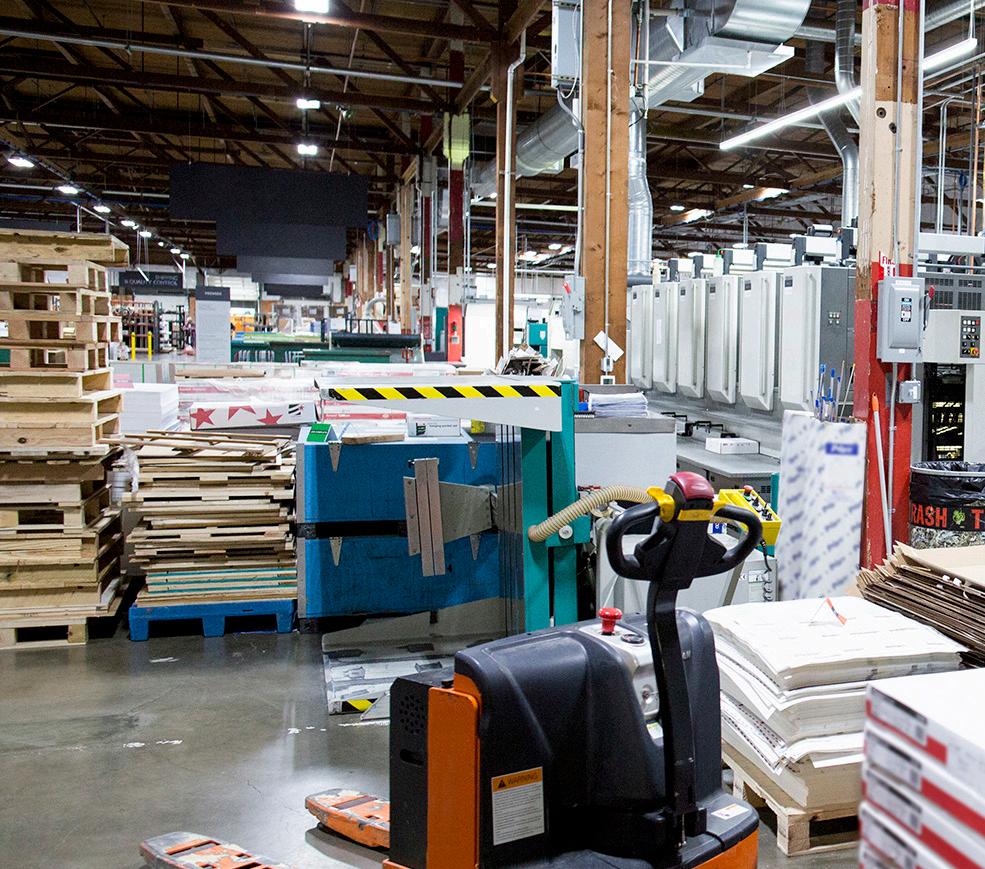
Gomez admits that, although most people know Microsoft as the company that created Windows and Xbox, for the past three years, “it has been doing a phenomenal job impacting industry digital transformation”.
Cloud helping Microsoft pioneer transformation projects
“With the advance of cloud computing and technology, we've had the opportunity to
YURY GOMEZ GLOBAL COMMERCIAL LEADER, PROCESS INDUSTRIES, MICROSOFT
“With advances in cloud computing and technology, we’ve been able to impact how industries think about the digital transformation journey”
impact how industries think about their digital transformation journey,” she adds.
The industry solutions and partner sales organisation of Microsoft is organised by industries. “In manufacturing there are two main kinds of companies: Discrete and Process,” explains Gomez. “For Discrete, you can think of aerospace, for example, but there is also process manufacturing, like chemical companies.”
Her role is to “elevate” customer journeys by “helping them envision how digital transformation can help them accelerate efficiency, increase return on investment, and transform the way they work”.
TITLE: GLOBAL CHIEF COMMERICIAL LEADER, PROCESS INDUSTRIES

COMPANY: MICROSOFT
LOCATION: UNITED STATES
Yury is the Global Chief Commercial & Strategy Officer
for the Process Manufacturing Industry division at Microsoft. She leads the GTM strategy and sales execution for process industries including chemicals, pharmaceuticals, CPG and others. In her role, she drives end-to-end digital transformation for Fortune 100 companies and many more working with engineering, sales, and partner teams.
Yury has over two decades of industry experience. Prior to joining Microsoft, she worked for Johnson & Johnson, Solvay, and various startups where she had multiple leadership roles leading innovation, manufacturing, E2E supply chain, commercial operations, and
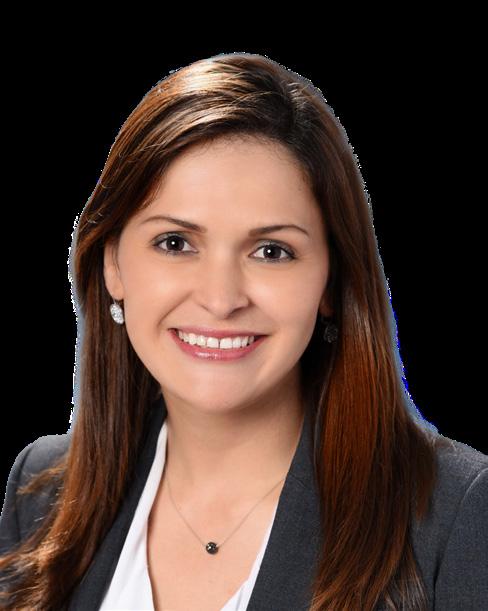



Supply chain digital twins must continue to evolve in order to drive optimal business outcomes. aThingz and Microsoft are delivering rapid transformation within global logistics organisations by fusing the informational (data), physical, and financial supply chains (the triple threat), and converging planning with execution (the double threat).
This new “Triple-Double” approach helps companies make faster, cost-optimised decisions that solve the most stubborn global logistics problem statements.
Learn more
aThingz is a unicorn supply chain and logistics solution provider enabling organisations to rapidly take cost out of their logistics spend while helping them be more agile and resilient. Customers reap accelerated value by week 6 with aThingz.
aThingz’s founders are Vijaya Neela, President & CEO and Kannan Ramachandran, Chief AI and Commercial Officer.
Vijaya establishes the supply chain transformation roadmap for customers and leads solution development and delivery engagements. Kannan is focused on aThingz’s AI strategy, managing customer relationships, and leading revenue growth initiatives.
“We are building solutions with an AI component that is a competitive differentiator for our customers. The speed and accuracy of business decisions rely on quality data. Our AI-powered purposebuilt data management solution for Supply Chain and Logistics can identify data anomalies, apply pattern
recognition techniques to standardize, cleanse, and improve the quality of data.”
Vijaya sets the vision for aThingz’s unique approach to global logistics management within the supply chain.



“We establish a customer digital twin model that overlays the physical, financial, and informational supply chain, and analyse historical planning and ongoing execution data to continuously calibrate the effectiveness of the plan. Planning and execution should not be considered two separate entities but should be a closed-loop process for optimal cost savings, efficiencies, and contextual insights.”
“We’ve been a strategic Microsoft partner for over five years,” says Kannan. “Our solution has been built ground up on their Azure stack using composable microservices. We leverage 100% of what Azure has to offer.”
“We will be co-piloting with Microsoft well into the future” says Kannan. “Our solutions use conversational AI, machine learning, deep learning, intelligent solvers, advanced heuristics, hyper automations, workflows, and alerts. Microsoft’s Azure stack has made it possible for us to drive accelerated innovation and business value for our customers.”
Gomez works with executives at C-Suite level to “better understand their business problems, how they are organised, and their operating models”. She then shares with them what Microsoft is doing in the wider world for other industries and customers.
She says: “I then go deeper into how Microsoft – with our cloud computing technology, our business applications and infrastructure – can help them transform.”

Crucially, she says, it is people who are always at the centre of my conversation with customers because “people are the lifeblood of how companies manufacture, operate and deliver products”. This approach informs Microsoft about the broader culture at the client, and the right journey and roadmap to help customers with a holistic approach to improve their operating processes and impact their workforce to work in new ways.

Microsoft empowering manufacturing firms to accelerate supply chain innovation
“We help transform everything – people, processes, data, and systems,” she explains, “so that these converge into a new journey that will transform how companies can do more with less, and in a more advanced way.”

So, what are the top supply chain challenges that her customers are facing today?
“The list is enormous,” she says, “but one thing we find most often is that customers need visibility.” This goes back to the effects of the pandemic. The main challenge is endto-end visibility in the value chain ecosystem.
“So visibility to multi-tier suppliers – not only tier one, but also tiers two and three. Also, visibility on customer data, how quickly inventory is turning over, and how the production systems are looking.”
This need for visibility has, according to Gomez, been heightened not only by the pandemic but also the knowledge that “market dynamics can impact supply at any time”.
“Take the Suez Canal blockage, or the Ukrainian war – the latter of which is causing a significant energy crisis impacting how companies operate and the manufacturing volumes they can sustain to maximise energy use.”
Despite difficulties, Gomez feels that, although the world is slowly returning to prepandemic just-in-time inventory models, today’s businesses want advanced digital tools to manage supply chain uncertainties.
Digital cloud-native technologies such as AI, analytics, blockchain, and IoT are helping customers build resilience and more visibility. Hence why end-to-end supply chain ecosystem visibility has become supremely important, she says “to improve production, planning, logistics, and cost efficiencies”.
Another challenge is how organisations can secure their supply chain “all the way to customers”, which she says makes logistics visibility and optimisation vitally important if companies are to achieve operational and financial goals.

Supply problems are in a constant state of flux Gomez and her colleagues at Microsoft seek to bring order to a disordered world, but she concedes that the challenges shape-shift from month to month, and that technology
also needs to change fast also to meet the needs of the evolving industry market.
“The pandemic is largely over but we’re continuing to see labour shortages that are impacting manufacturing industries, and manufacturing is a big piece of enabling the supply chain,” she says.
“People are also retiring younger, and there’s a lack of skilled people who know and understand digital technologies. Businesses have to operate faster to have competitive advantage, so all this is a challenge that’s added into the existing complexity.”
Gomez also references the rampant inflation occurring around the globe: “This is putting a lot of pressure on companies to digitise even faster to reduce their operating costs.
“So, a customer that has already started on the digital transformation journey and is getting close to a higher maturity stage – and that has visibility around suppliers, customers, and manufacturing production – is suddenly hit by spiralling inflation. It can sometimes feel like it’s difficult to keep up, especially if you are trying to do this on your own.”
She adds: “Taxes are also rising, and debt is increasing, and companies need to pass this down to consumers or customers. But to what degree? How far can they go before customers seek out a competitor, whose prices are lower?”
These are the kind of fluctuating dynamics that Microsoft is helping businesses tackle, mainly through its cloud solutions.
AI-enabled cloud products mark out Microsoft as unique for industry digitalisation
Its AI-enabled cloud products mark out Microsoft as unique. They demonstrate the company’s commitment to industryspecific standards and communities, such as the Open Manufacturing Platform, the OPC Foundation, and the Digital Twins Consortium.
Coupled with this is its innovative partner ecosystem, featuring composable and extensible solutions that seamlessly connect people, assets, workflows, and business processes.

“Our technology is giving businesses more intelligence and visibility than ever before, while making operations more adaptable,” she says.
Data is, it seems, the key driving force – both in the need for such solutions and the way in which they operate, as Gomez says: “We realise that though companies have a lot of data, it's siloed so they can't make much sense out of it. So we give them the infrastructure and technology they need to unify this data, helping them gain advanced insight into their supply chain to make better decisions.”
Referencing Microsoft’s partner ecosystems, Gomez says the company “leverages partners to help industry”,
adding: “Every customer wants to prioritise certain aspects of their supply chain, and we have partners that play very well to all these various needs – whether it’s end-to-end or for specific functions of the supply chain.
“We partner with ecosystem companies to bring the operational efficiency and agility that companies are looking for. Most importantly, we recognise customers’ need to simplify the way they work with vendors while ensuring a secure platform that’s flexible and extensible. We built Microsoft Supply Chain Center because we recognise this security and flexibility is very important.”
Gomez describes Microsoft as “the most trusted, secure cloud provider that provides the infrastructure and connectivity to partner solutions”, adding that the very nature of the platform is to recognise that “no one partner has everything a customer needs and so it provides a platform to enable an ecosystem of solutions”.
This ecosystem is helping Microsoft modernise supply chains, which by nature are complex, and involve many operational steps and activities, whether it’s manufacturing, procurement or logistics.
“There are many partners we work with to address the various challenges in supply chain,” says Gomez, “and we bring them together to light up the digital transformation of the supply chain.”
She adds: “Partners are the lifeblood of how we execute transformation. They have deep knowledge of the industry and know what, exactly, is the right solution. And then we, Microsoft, bring our secure and intelligent infrastructure technology
to enable our partner to deliver a solution that is secure and that leverages the best cloud-based digital capabilities and latest solutions to enable customers to become more agile and resilient.”
Businesses, she says, have discovered that operational and supply chain resilience is the key to their competitive advantage; to help them build this resilience, “I encourage customers to work with us to advance their digital journey”.
“The start point is always what they are doing today,” says Gomez. “What's your current state? What are your top operational problems? What is your digital maturity? Then we bring them the digital solutions and roadmaps to help them orchestrate, so they can better plan and optimise to improve their supply chain visibility, execution and logistics models.”
“Most importantly,” she adds, “we deliver all of this in a secure manner, meaning customers can really embrace digital transformation.”
This is where Gomez’s supply chain experience stands her in good stead.
She says: “Before Microsoft, I was part of industry myself. I was a leader of supply chain, and so I understood that supply chain people often don't know how to get started on digital transformations.
“To build resilience, supply chain leaders have to understand how digital capabilities can enhance each step of the supply chain operational process. It’s about working with partners and getting a dynamic going. I think that’s how companies can start their journey toward building a more resilient supply chain.”


 WRITTEN BY: TOM CHAPMAN
PRODUCED BY: KRIS PALMER
WRITTEN BY: TOM CHAPMAN
PRODUCED BY: KRIS PALMER


For more than 150 years, Bizerba has been a pioneer in the food industry with its world-leading weighing, slicing and labelling technologies.
Underpinning the German firm’s everyday operations is the motto ‘stronger together’, which is adhered to and embraced by every team, from sales to human resources.

The IT department, containing around 150 employees in locations across the globe, is no different.
Heading up this function is Dr Christian Hürter, Director Global IT, who joined the company just over two years ago in February 2021.
Dr Hürter leads the talented team of IT specialists, around 100 of whom are based at Bizerba’s headquarters near Stuttgart, Germany, with the other 50 spread all over the world.
Revealing his approach to the role, Dr Hürter said efforts to “lift IT to the next level” at Bizerba could be broadly summarised by two pillars.
“We want to reach the next level in terms of standardised architecture, enabling a stable development application-wise,” adds Dr Hürter.
Christian Hürter, Director Global IT at Bizerba, discusses how the company is overcoming new challenges in a rapidlyevolving digital landscape
“With one pillar we are really working to global IT standards, so we are not reinventing the wheel. We are working closely with Gartner to establish those standards.
“On the other side, we have six strategic initiatives which help us bring Bizerba to the next level. These are things like the introduction of business relationship management, as it’s very important for us to be business-centric; another initiative is IT performance management which means being transparent in what we are doing and shifting focus from running IT towards growing and transforming business with IT.
“And so, with those two pillars, we are evolving as a global team step by step.”
Bizerba: A company ‘stronger together’ Dr Hürter cannot emphasise enough the importance of staying ‘stronger together’. So endemic is the mantra that it has actually extended to Bizerba’s customers through the ‘MyBizerba’ initiative.

Given the business’ multiple areas of expertise, MyBizerba allows clients to benefit from an entire portfolio of services, tailored to their own specific set of requirements. This includes full technical training and extensive maintenance and support packages.
“Our claim of MyBizerba means we create unique solutions for unique people, combining functionalities like advisory services, hardware and software products, accessories, services and financial services together in this ‘stronger together’ thinking,” says Dr Hürter. “Because we are a global company in several different countries, our people must work together to come up with a working solution for our customers.
Why Bizerba prides itself on being ‘stronger together’
TITLE: DIRECTOR GLOBAL IT
COMPANY: BIZERBA
INDUSTRY: IT
Since 2021: Director Global IT (CIO) at Bizerba
2018-2020: Co-Founder and

“Because we are a global company in several different countries, we all must work together to come up with a working solution for our customer”
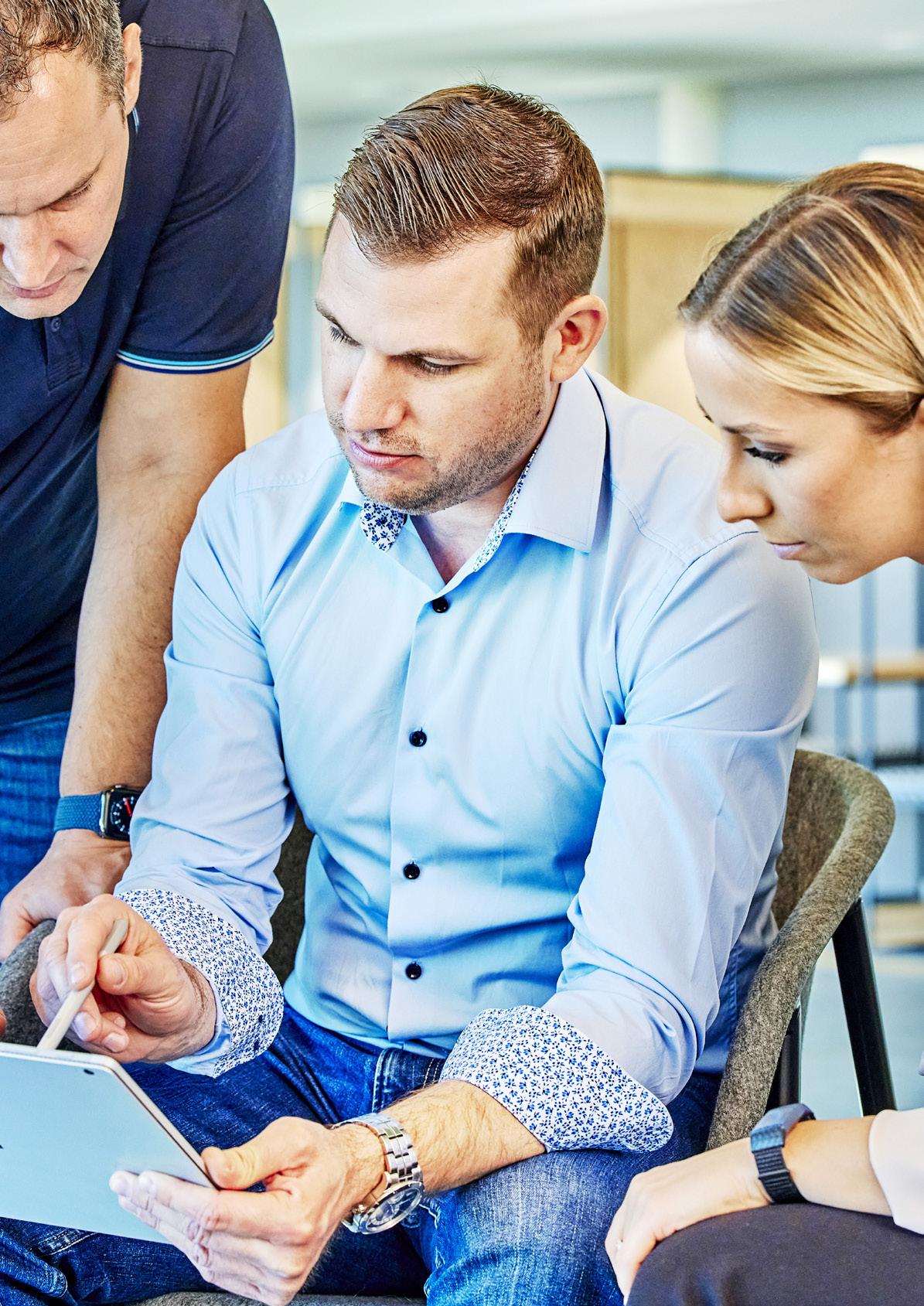 CHRISTIAN HÜRTER DIRECTOR GLOBAL
CHRISTIAN HÜRTER DIRECTOR GLOBAL
We see this in every aspect of our work, especially in IT.
“I already mentioned we act businesscentric, so what matters most to IT is what our customer needs, and then we make that happen in a joint effort together at Bizerba.

“Being a large, mid-sized business, and given the scale of our products and global footprint, it’s all about taking this asset we have as an advantage and combining different people and knowledge to come up with solutions. That’s our daily business.”
Evidently, key to Dr Hürter’s role –and that of his IT department – is to try and respond and adapt to rapidlyevolving business requirements.
He highlights sustainability, digital transformation and the digital skills gap, which he refers to as the “war for talent”, as just some of the biggest challenges to overcome.
“We are seeing some important changes around us and I think it’s important that, in IT, we are grasping what’s happening on the market,” says Dr Hürter. “We have influences like sustainability which is just taking off and that is something we need to take care of everywhere in the company and of course in IT, too.
“We have this war for talents that is definitely affecting us in the IT organisation; we need to continuously ensure that we have
IT, BIZERBA“We are seeing some important changes around us and I think it’s important that, in IT, we are grasping what’s happening on the market”CHRISTIAN HÜRTER DIRECTOR GLOBAL IT, BIZERBA
the right capabilities and stay ahead of our competitors in the market.”
New innovations within the food and retail industries are also presenting new hurdles, as are ever-evolving business models.

Unmanned supermarkets and selfcheckout capabilities are becoming increasingly common, while the way in which clients are paying for services is changing, too.
“For example,” adds Dr Hürter, “Bizerba is partnering with a start-up called SuperSmart, which is coming up with brilliant solutions for supporting selfcheckout for large bunches of products, as well as for small product bunches.
“Ever since the cyber attack, we are progressing faster than we ever thought we could. We are learning and improving massively on every aspect”
“Parallel to the traditional selling of products, we have more and more users willing to pay only when they use services. So we are experiencing more of this type of subscription business model.”
Bizerba’s push for digital transformation falls under its I&T operating model, which has been coined by Gartner to express that the scope extends beyond the boundaries of the IT organisation.
While digital transformation may once have been a department in itself, emphasis now is on this drive being part of an entire company’s DNA – another example of being ‘stronger together’.
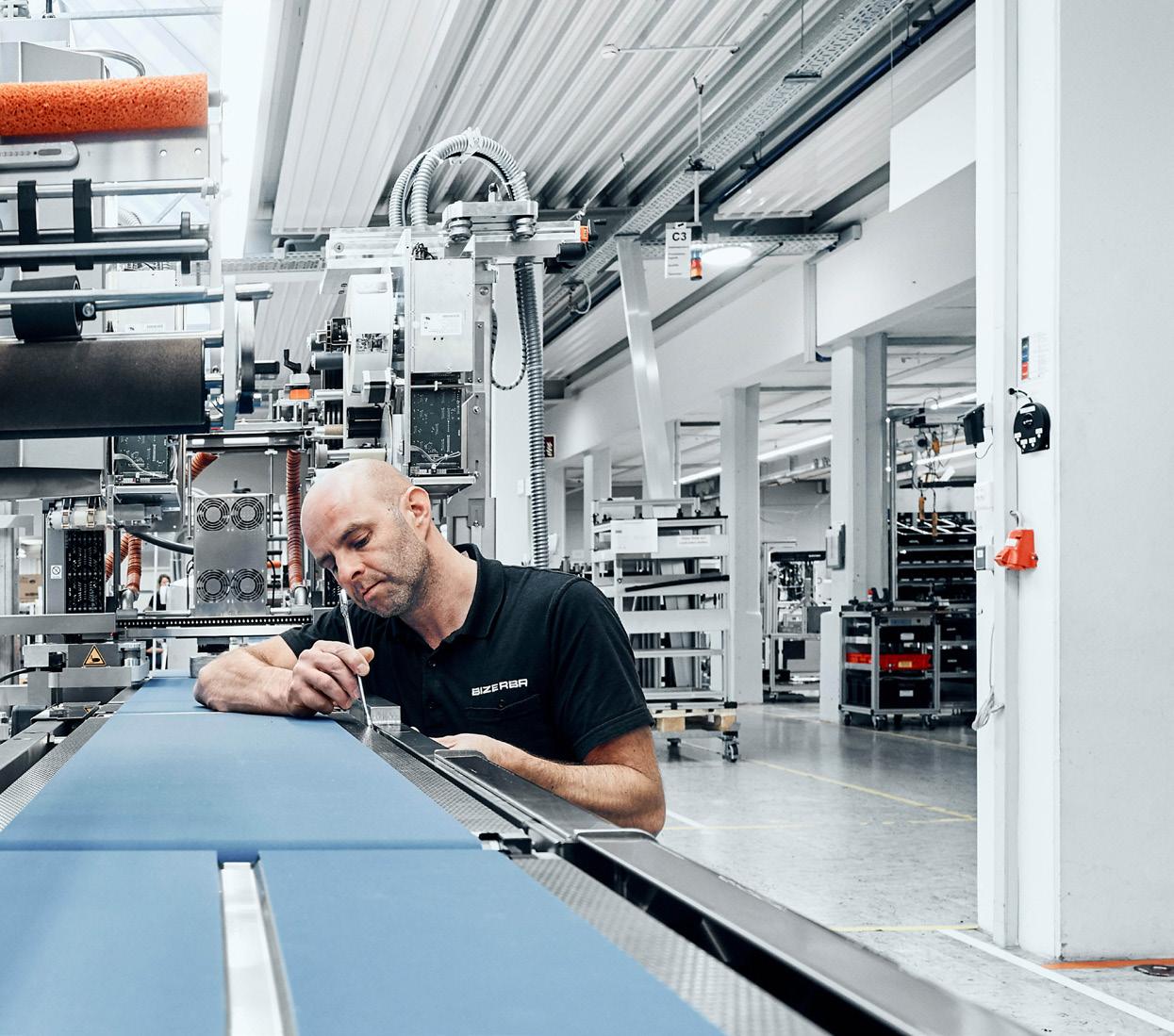
Bizerba ‘building back better’ after
Dr Hürter does not shy away from the fact that Bizerba has been in recovery mode, having suffered a severe cyber attack in June last year.
While basic functions were restored after a few weeks, the establishment of a new IT landscape took several months.
However, the experience served as an opportunity for the company to learn and ‘build back better’, reinforcing its global infrastructure including networks, server, cloud and security.
“Actually, we weren’t bad before and were performing pretty well,” explains Dr Hürter.
Open up opportunities across edges, colos and data centers when you complete your hybrid cloud with HPE GreenLake, the open and secure edge-to-cloud platform.

“But, we were hit and now we are learning from that and improving massively on every aspect. We are at a very good point – much better than we were a year ago, even though we had a good level. Now, ever since the attack, we are progressing faster than we ever thought we could.”
In fact, Dr Hürter grows discernibly excited when the topic of security is brought up, even admitting it is his “favourite” part of the job.
He uses the analogy of security being like a fence surrounding Bizerba, with a need to ensure it reaches the same height all the way around.
“The risk appetite that our shareholders define is the fence height, and our shareholders want it pretty high,” says Dr Hürter.
“Our duty in IT is to ensure we have the same fence height everywhere in the company, and it’s the duty of my colleague, the Chief Information Security Officer, to watch over and inspect the fence.”
The importance of GPOs and IT-BRMs Bizerba’s Director Global IT is unequivocal in his assessment that his team must contribute to the value being added to business processes.

Facilitating this is the global process owner (GPO), defined by Deloitte as an individual who “owns an end-to-end process across functional silos, geographic and business unit boundaries.”
Dr Hürter calls this “absolutely crucial” and says his team is working closely with Bizerba’s GPO through an IT Business Relationship Manager (IT-BRM), established at the beginning of last year.
He adds: “The important thing is that the GPO and IT-BRM are in close contact, so the IT-BRM can understand and fulfil the needs of the GPO, and consult the GPO on their way of digitally transforming the business.”
CHRISTIAN HÜRTER DIRECTOR GLOBAL IT, BIZERBA
“Our strategic partners like HPE and All for One are bringing us to the next level, technology-wise, in our global ecosystem”
1866 Year founded
4.5K+ Number of Employees
€800 mn Annual revenue

CHRISTIAN HÜRTER DIRECTOR GLOBAL IT, BIZERBA
“Our partnerships go longer because that’s the way we need to work together”
Bizerba’s IT function does, of course, have a whole host of partners with which it works closely on various production and transformation processes.
Once again, this epitomises the ‘stronger together’ ethos which extends beyond the company’s four walls.
“I think today you cannot compete in the transformation and production of an IT organisation when you need to invent everything on your own,” says Dr Hürter. “It would be a stupid approach, not taking into account the multiple experiences and sometimes the overarching size of partners in the marketplace. These are important value partners with many more resources or many more specialisations.
“So, it’s absolutely crucial and, again, a case of ‘stronger together’ when you have these long relationships with partners.”
He also points out the growing trend in establishing enduring partnerships to ensure long-lasting stability and fruitful relationships.
“We are investing and concentrating on a few very good partners, and I think that’s a trend in the market as well,” Dr Hürter continues.
“Our partnerships go longer because that’s the way we need to work together.”
All for One Group is one of the key partners within Bizerba’s ecosystem, supporting the company in its transition to SAP’s S/4HANA enterprise resource planning software.
“For this transition, we chose All for One as our favoured partner,” adds Dr Hürter. “All for One has always been our partner for basic support. Above all, they are now our project and transformation partner who are making our transition to S/4HANA happen. And why? All for One understands

our needs and can advise us individually in our specific situation, but they also have a broad market experience and offer us guidelines and best practices to navigate through business transformation.”
Another important partner is Hewlett Packard Enterprise (HPE).
“HPE is supplying us with storage and computing for our data centre but,

CHRISTIAN HÜRTER DIRECTOR GLOBAL IT, BIZERBA
“It’s more important to choose the right path and to make the right migration decisions”
moreover, they are infrastructure problem solvers and precious advisors on our journey to hybrid cloud transition,” Dr Hürter says.
He describes hybrid cloud transition as Bizerba’s “stepwise move from processing data in proprietary data centres to a hybrid cloud”, provided and managed outside Bizerba.
“We are not in a hurry during this transition phase,” concludes Dr Hürter. “It’s more important to choose the right path and to make the right migration decisions, because mistakes are very expensive. And HPE is helping us avoid such mistakes.”




WRITTEN BY: MARCUS LAW

PRODUCED BY: TOM VENTURO


Few startups can say they have a background like Eviden. A new company carved out of French multinational information technology service and consulting company Atos, Eviden’s mission is to help its clients accelerate their digital future.
As Daniel Sinni, Global Head of Innovation and Digital Transformation at Eviden’s Financial Services & Insurance business, explains, the purpose of Eviden is to be the leader in data-driven, trusted, and sustainable digital transformation.
Speaking with Sinni just two weeks after the official launch of Eviden, his enthusiasm is clear. “We just learned the name Eviden,” he says. “Eviden evokes this response of creating new paths forward, transforming possibility into reality, and that’s really what the company is going to drive. We are all super excited to go!”
“It’s rare that you can say you’re part of a €5bn startup, but that’s what Eviden is,” Sinni adds. “We have nearly 60,000 people and 2,100 patents. It is purpose-built to take our clients into the next world of digital transformation, which includes digital integration. Our clients are really struggling with their amalgamation of heritage systems and processes, as well as integrating with the highly disruptive technologies, ecosystems and operation models that drive value. That’s where a lot of the problems need to be solved, and I’m really proud to be part of that solution.”

As Sinni describes, his team helps financial services and insurance customers realise the benefits of digital transformation. Central to this journey is the creation of a new

operating model. “You can’t do that without a team of really passionate experts in those different domains,” Sinni explains. “And then you need a company that is laser focused on that outcome, which Eviden is, as well as having the capability and knowledge of those heritage systems. This is essential to success, tying it all together”
When you take a company the size of Eviden and combine it with the resources of Atos, it’d be difficult to dream up many other companies, globally, that have as much expertise at scale when it comes to enabling digital transformations.
“Many of the companies that we deal with – specifically in the case of financial services
“It’s rare that you can say you’re part of a €5bn startup, but that’s what Eviden is”
DANIEL SINNI GLOBAL HEAD OF INNOVATION AND DIGITAL TRANSFORMATION, EVIDEN
and insurance – they’ve been around for 100 years, and have heritage systems and regulatory constraints that are really heavy,” Sinni explains. “If they were born today, they would be a FinTech company and they would be fast and agile, but they’re not; they’re a monolithic enterprise aspiring (but often failing) for digital change.
“There are not many companies in the world that can help bridge the two,” Sinni adds. “We understand the heritage systems, and now we’re bringing them into the new world of these operating models and these disruptive technologies. That’s what makes my group really unique and special – because we have that DNA and we have been there done that….”
TITLE: GLOBAL HEAD OF INNOVATION AND DIGITAL TRANSFORMATION
COMPANY: EVIDEN
INDUSTRY: IT SERVICES
LOCATION: NEW YORK, US
Daniel Sinni has spent his career advising Fortune 500 clients in digital transformation - specifically disruptive open-source software, AI and cyber risk management.

After graduating from the University of Delaware and joining the emerging telecoms space with Network Plus, Sinni worked for Deloitte before co-founding N-Tier Discoverya premier legal process outsourcing and AI consulting firm where he would serve as COO.
With the business acquired by RVM Enterprises in 2012, Sinni would rejoin Deloitte, before serving in various leadership roles for SunGard Availability Services and Dell EMC Global Consulting Services, before joining Pivotal Software.
Now at Eviden, he is globally responsible for its Financial Services & Insurance Consulting’s Digital Transformation and Innovation Market Leaders, Blockchain/ Digital Assets practice, Federated Fraud/Financial Crime, AI, crosspractice solutions, and strategic acquisitions.

foundation of a successful brand
FALKOR SI is the trusted blockchain platform that’s easy to use
With FALKOR SI, and ByzGen’s expert support, innovators at Atos deploy blockchain solutions that make digital and data integrations reliable and secure.
ByzGen. We make blockchain your business.

Learn more

Be innovative. Reveal new revenue streams. Help your clients build a trustworthy business.
When it comes to data, blockchain is a secure and auditable integration solution. It’s inherently trustworthy. Which is why in regulated sectors, consultants like Atos use FALKOR SI when companies need to share data quickly, securely, and without compromise.
FALKOR SI is ByzGen’s enterprise blockchain platform. Blockchain improves data quality and integrity by maintaining an immutable record of data and transactions – everyone involved can access accurate records. Blockchain platforms like FALKOR SI help people exchange data, make better decisions, and comply with regulations. This makes FALKOR SI ideal for finance, legal, manufacturing and supply chain – sectors that depend on security, trust and traceability.

Atos use FALKOR SI to build secure and scalable digital integrations, fast. With this proven blockchain solution in their hands, consulting leaders at Atos and its new carve-out company Eviden, are winning new work and increasing the value of existing contracts.
ByzGen’s FALKOR platform is built for system integrators like Atos and Eviden. Our partnership with ByzGen is a perfect example of why it is important to work with a proven partner who understands how they can help you as a progressive digital transformation partner.
Daniel Sinni, Global Head of Innovation and Digital Transformation, Eviden.
Unlock new revenue streams with FALKOR SI
FALKOR SI, coupled with ByzGen’s consulting services, makes solving complex data challenges simple. Projects that might have taken years to deliver value now do that in weeks.
Using FALKOR SI our partners have:
y Reduced operating costs by 80% for a regulatory reporting service
y Helped a manufacturer reduce power usage by 20%
y Won projects worth £50m
FALKOR SI makes deploying your blockchain solution quick and easy. Backed by ByzGen’s expertise, it’s a tool you can trust.


Central to the aim of Eviden is to help organisations on their journey from digital transformation to one of digital integration at scale.
“The pandemic made it really clear that the world has fully embraced digital,” he explains. “We’ve learned that technology is a massive enabler if used the right way, and if you integrate it into your operating model, into the way that you do business and connect with your customers - that’s extremely powerful.”
With startups using platforms such as blockchain as well as new generative AI capabilities, the question of how best to integrate them into legacy operating models and heavily invested systems is
“Eviden evokes this response of creating new paths forward, transforming possibility into reality, and that’s really what the company is going to drive”
The €5bn startup helping clients embrace digital integration
WATCH NOW
DANIEL SINNI
GLOBAL HEAD OF INNOVATION AND DIGITAL TRANSFORMATION, EVIDEN
an ongoing challenge. This is often new territory for most companies and they struggle holistically to get their arms around how best to tackle this disruptive change. Not to mention the evolving global regulatory and compliance landscape.
“You’d be surprised how many mission critical things still run on a mainframe,” Sinni comments. “Yes, these systems are known to be reliable but also a major barrier to new opportunities and often very expensive. Not to mention those folks are retiring, and those skill sets are going away fast. The question today is how we fix that in a way that doesn’t break the bank and increase risk, yet drives the agility and the new opportunities all companies want to accelerate. You need to have domain expertise on both sides of the coin here to win.
“That is digital integration, and that’s where we are right now. That’s what’s painful, that’s what’s hard. That’s what can be expensive and high risk. And to achieve that, you need an experienced partner. At Eviden, we can be your trusted partner in this journey end-to-end.”
However, as Sinni warns, there is no “silver bullet solution” when it comes to digital integration.
“ To lift and shift something into the cloud is arguably straightforward,” he says, “but making that work with low toil, making it compliant, and making it tie into the heritage systems with low friction is very, very hard.”

When it comes to migrating from legacy platforms, digital transformation or
57,000 People
2,100 Patents 50,000 Digital Certifications
€5bn Revenue

strategic innovation, Sinni describes the five ‘S’s: speed to market, stability, security, scalability, and savings. As he explains, technology for the sake of technology should be avoided.
“The first S is speed to market. Can you get to the market faster than your competitors? Can you use technology as a competitive weapon?
“The second,” he adds, “is stability. There are a lot of challenges in technology around the stability of systems. They’re often ducttaped together... When things are unstable, customers can’t get into systems, things don’t work well. You must have consistent and reliable platform stability at scale.
The third is advanced security postures. “Security has to be the cornerstone,” Sinni explains. “Companies don’t tend to exist when they’re breached and trust is compromised.

“The question today is how we fix that in a way that doesn’t break the bank and create risk, yet drives the agility and the new directions that we want to go”
DANIEL SINNI GLOBAL HEAD OF INNOVATION AND DIGITAL TRANSFORMATION, EVIDEN
“The fourth thing is scalability. Can you meet your customer’s demand at scale? You need cloud-like scalability, you need elastic services around that. You need resilient automation of those things to be able to scale, to meet the demands so that you can continue to service your customer’s needs.
“And, then, last is really savings,” he explains. “Ultimately, there’s always an investment or sometimes they pay for themselves. If you do rapid smaller projects, you get success and you build on top of that - it becomes infectious in an organisation. Business funding becomes more accessible. That’s ideally the approach - to have things pay for themselves by earning the right to the next phase and continuality winning as a team.
Key to all of this is using technology based on business outcomes. “If you don’t have those five S’s, then you probably shouldn’t move forward with certain initiatives,” Sinni asserts. “There are pieces of technology everywhere, but it doesn’t make sense unless it accelerates your business. Tech tinkering without the support and collaboration of the business is often a fool’s errand.”

Working with companies like Google, Microsoft, VMware, Eviden benefits from its relationships with a number of large and small partners. One such partnership, with ByzGen, is particularly special.
– streamlines data exchange by empowering decision-makers with a safe and secure process to share sensitive information.
Blockchain is often aligned with only cryptocurrency, which has seen its share of hype and fraud these past years. But as Sinni explains, thinking of blockchain
as an infrastructure and a decentralised ecosystem can be very powerful and can solve important enterprise challenges.
“ByzGen’s FALKOR platform is built for system integrators like Atos/Eviden,” Sinni explains. “Our partnership with ByzGen is a perfect example of why it is important to work with a proven partner who understands how they can help you as a progressive digital transformation partner.
“We’ll give them use cases, they give us use cases, and we iterate on that together. We have trust together built through successful projects with our clients. We’ll go to market with them, they’ll go to market with us, and we co-innovate together to be able to drive these outcomes with our clients. ByzGen is also part of our Eviden and Atos innovation programmes that we call Scaler and Horizons.
“It’s a very special relationship; it’s one that’s been very successful, and we’re going to continue to build on that with Eviden.”
With the accelerated capabilities of AI taking off in recent years, this topic will continue to dominate as organisations learn more about how they can harness its potential.

“There are some amazing use cases that are coming out – banks, firms and institutions are already modifying their operating models to utilise AI,” Sinni comments. “Those use cases are going
to expand as the models become more intelligent and integration will be critical to success. I also think that there’s going to be some consolidation in fintechs, which could be an opportunity for Eviden.”
Sinni also predicts that usage of Web3 technologies like blockchain and IoT technology will continue to increase.
“Juvenile crypto projects and fraud will decrease and successful projects with true utility will be further advanced given strong developer and user communities,” he says. “Financial services companies are already using blockchain as digital asset infrastructure. But blockchain can also be used as customer loyalty solutions to create new opportunities, democratise data, and enhance brand loyalty. The convergence
“ByzGen’s FALKOR platform is built for system integrators like Atos”

of these new technologies, use cases and challenges is exciting to be a part of.”
Fundamentally, when it comes to regulation, taking a balanced approach is key so as to not impede innovation but provide proper guard rails. “AI will be one of the most disruptive technologies in many industries and as a society we need to ensure its nefarious capabilities are mitigated,” Sinni asserts. “If we can do that, we will unlock these new possibilities that will be driving the next amazing discoveries and opportunities.
“Those things excite me, and that’s going to be happening at a rapid pace. The digital content and breakthroughs will be built from a lot of these newer technologies. It will be one hell of a ride!”
As Sinni explains, the near future will be one of promoting and proselytising Eviden as the business launches.
“We’re going to be showcasing all of these really cool digital projects, evangelising them and innovating with customers to help them accelerate their digital ambitions,” he says. “I’m really happy to be part of that because, in the past six or seven months, we have worked hard to assemble the right teams and go-tomarket - we’re more than ready to go.
“I have an amazing global team; we’re all very passionate in our domains, to work with our customers and build some amazing outcomes, but just as important, to get involved in some really great partnerships. I’m super pumped to help build Eviden!
“It’s going to be super busy,” he concludes. “It’s going to be a lot of fun. It’s going to be a little chaotic, but I think we’re all going to benefit – especially our clients.”


Barely a decade into the popularisation of electric vehicles, Faraday Future is launching the first ultra-tech luxury electric vehicle: meet the FF 91


Prashant Gulati is the esteemed Vice President of Strategy at Faraday Future. Now in his seventh year with the company, he handles the entirety of its strategic roadmap, which includes overseeing the business plan, mobility initiatives, manufacturing strategy, and directing fundraising efforts.
Fundraising is a key part of Gulati’s role: “My proudest professional achievement has been co-leading the public offering, which helped the company raise more than $1bn through a listing on NASDAQ,” he says.
With over 20 years of success in the technology and automotive industries, Gulati is an accomplished executive with a track record of scaling businesses. He has successfully led a public offering and held leadership roles to drive growth and expansion at several companies globally. In recognition of his industry contributions, Gulati was selected for the coveted Business Insider list of EV Industry Power Players.
Gulati holds a bachelor's degree in computer science and an MBA from the Indian School of Business.
Having grown up in India, Gulati has always had a deep affinity for the environment. This draw of environmental stewardship was heightened when Gulati and his wife were expecting their first child. “I had a sense of urgency to contribute to technology that could help slow climate change and create a better world for our children to grow up in,” he explained.
“I explored numerous fields, including renewable energy, smart grids and energy storage, before focusing on EVs and finding



Faraday Future. I immediately clicked with the company as it had such a bold vision and fit the environmentally-focused technological approach I was seeking. My journey into the auto industry has been quite unusual – almost accidental.”

Faraday Future: driving the EV industry
“Climate change is the defining challenge of our time, and transportation is one of the largest contributors to it,” says Gulati. “At the same time, the world cannot slow down. We need more growth, more productivity, more time to commit to our passions. So, at Faraday Future, we've been working on the intersection of these problems - of clean mobility and climate change on one

“We were founded with the mission to help people live, move, and breathe more freely – and that's one of the things that drives a lot of us”
PRASHANT GULATI VICE PRESIDENT OF STRATEGY, FARADAY FUTURE
hand, and helping people lead productive, connected lives on the other.”
Faraday Future has taken the first step towards achieving that mission by building the FF 91, which Gulati believes is the most connected, comfortable, and technologically advanced electric car in the world. The company achieved start of production of the FF 91 in California and plans to sell it through a direct sales model in its dual home bases of the US and China.
“The vision of the company is much more than building and selling electric cars, though,” Gulati tells us. “We want to engage our users, build a community, and offer internet and AI services throughout the vehicle lifecycle.”

TITLE: VICE PRESIDENT OF STRATEGY
INDUSTRY: MOTOR VEHICLE MANUFACTURING
LOCATION: UNITED STATES
Prashant Gulati is the esteemed Vice President of Strategy at Faraday Future. Now in his seventh year with the company, he handles the entirety of its strategic roadmap, which includes overseeing the business plan, mobility initiatives, manufacturing strategy, and directing fundraising efforts.
With over 20 years of success in the technology and automotive industries, Gulati is an accomplished executive with a track record of scaling businesses. He has successfully led a public offering and held leadership roles to drive growth and expansion at several companies globally. In recognition of his industry contributions, Gulati was selected for the coveted Business Insider list of EV Industry Power Players.
Gulati holds a bachelor's degree in computer science and an MBA from the Indian School of Business.

WE DESIGN. WE ENGINEER. WE MANUFACTURE.
Our advanced electrical and lighting, battery storage, and thermal management solutions are the key to turning your ideas into reality. Trust us to provide smart solutions for your global technology needs and deliver results beyond your expectations.
Contact us today and let’s bring your product vision to life together.

In an exclusive interview, Jason Murar, President and CEO of JVIS USA, discusses how JVIS is pioneering the EV industry while supporting Faraday Future
JVIS USA is a world-renowned manufacturing leader boasting unrivalled proficiency across both design and engineering. Blending state-of-the-art technologies with vertically-integrated processes, the company guides a concept from the initial sketch to the final product launch, and everything in between.

By prioritising innovation, JVIS has established itself as a leader in the continuous shift towards electric vehicles (EVs). It specialises in delivering technology and components uniquely optimised for EVs, continuously seeking out novel concepts, technologies, and procedures.
JVIS has also played a vital role in supporting Faraday Future (FF) to unveil their vehicles to the market. Jason Murar, President and CEO of JVIS USA, explains:
“We’ve assisted FF in almost every facet, from the initial product development – where we identified key product innovations for their consumers – all the way through to the actual testing and validation, in compliance with automotive standards for those components and the continuous supply of critical components used in their vehicles.

Armed with impressive electrical solutions, JVIS employs the latest technology, such as capacitive touch surfaces and smart panels.
Murar says: “In the EV market, you see a lot of change with smart panels, which are now highly integrated into both the exterior and interior of vehicles.”
JVIS is committed to leading the development of the EV industry, particularly as it plays a large part in the company’s growth. “Our customers see how we’re taking static panels and turning them into functional panels, giving expanded use of the vehicle,” Murar explains. “These components include sensors and software to increase the user’s experience, such as soft-close doors and ambient lighting.
“JVIS’s continued investment in innovation and growth will enable us to make significant contributions to this dynamic field. If you are looking to turn your product ideas into reality, contact us today to learn more about how JVIS technology can help.”

Faraday Future started from scratch, taking a “clean sheet approach” to building electric cars. Faraday Future’s technology innovations include its proprietary Variable Platform Architecture (VPA), propulsion system, and Internet, Autonomous Driving, and Intelligence (I.A.I.) systems. The company has approximately 660 patents across these areas.
“So far, the company has invested billions of dollars in creating industry-leading product and technology,” recounts Gulati. “Building cars is a capital-intensive business, and we've had our ups and downs.
“The way I would describe the ethos of the company is one of perseverance and tenacity; one of never, ever giving up in the service of our mission.”
The FF 91 has been designed as an all-ability car, possessing the handling of a sedan, the space, reliability, and comfort of an SUV, and the top-level performance and driving dynamics of a sports car.
“A lot of people liken it to a Rolls-Royce, with increased comfort, connectivity, and performance ” Gulati tells us – and the statistics certainly speak for themselves.
video conferencing, and watch movies or live sports without driver distraction”
“There's a lot that has gone into developing and thinking about the design, driving experience, and the overall user experience” says Gulati who is incredibly passionate about the vehicle.
“There is no electric car in our segment right now – competing with Rolls-Royce,

Bentley, Maybach – so we're quite excited about being the first EV of our kind, and we think it's going to redefine industry standards. The first ultra-tech luxury electric vehicle.”


“We are building what we believe is the most connected, most comfortable, most technologicallyadvanced electric car in the world: we call it the FF 91”
PRASHANT GULATI VICE PRESIDENT OF STRATEGY, FARADAY FUTURE

The technology under the bonnet Faraday Future describes the technology behind the FF 91 within three pillars:
1. Variable Platform Architecture
“Think of it like a Lego,” Gulati explains: “You can change the size of the platform and build different vehicles of different sizes for different purposes. You can put different motor and powertrain configurations. This skateboard-like platform approach enables us to build multiple vehicles on the same platform, reduce time to cost, time to market, and more.”
2. In-house Propulsion Technology
Faraday Future has developed a proprietary inverter design and propulsion system. The drive units are fully integrated with the inverter, and transmission and control unit to enable leading horsepower, efficiency, and acceleration.
3. Internet, Autonomous Driving, and Intelligence (I.A.I.)
“Our software, internet, and AI development is the most important of these pillars,” says Gulati. “That's where the company shines compared to all of our competition.” Faraday Future’s commitment to these technologies supports the user experience in the car, both practically and luxuriously, ensuring seamless user experience through different elements, one of which is advanced voice control to manage complex queries without driver or passenger distraction.



• 3 motors
• 1,050 horsepower
• 0 to 60 in 2.27 seconds
• Class leading EPA and CARB certified range of 381 miles
• Charge Time (20-80%): 25 min @ 200kW DC Fast Charge
• Overall length: 5,250mm/ 206.7in
• Up to three 5G modems and a newly developed operating system, allowing customers to use apps and stay fully connected
• Industry-leading 49 inches of rear seat legroom
• 60-degrees rear seat recline in NASA-inspired, zero-gravity seats
Faraday Future invested a lot in creating its own technology. “Some companies basically source parts and build a car, essentially becoming assemblers,” explains Gulati. “At Faraday Future, we've invested a lot of time and capital on creating our own technology.”
Faraday Future has strong partnerships with, and relies on, key suppliers to ensure the FF 91 is completed in a timely manner and with the high quality its users will demand. The company was affected to a lesser degree by supply chain issues during the pandemic because of planned low volumes at launch, and because many of the parts are created by suppliers uniquely
for the FF 91, and so we don't compete with others for those. Notwithstanding, the company has taken lessons from that period and gotten even more diligent about planning and ordering across the supply chain.
In terms of scale, Faraday Future employs 590 people across the US and China, and with its production plant in California the company will ultimately be capable of producing approximately 10,000 vehicles per year. The current manufacturing setup is asset light, and the supply chain is built with expansion in mind: if needed, the company has a contract manufacturing partner for this anticipated expansion, allowing early-stage flexibility.

“The company's DNA is completely global,” Gulati says: “We've designed and defined the product with an abundance of cutting-edge technology to cater to a global audience.”
The company is headquartered in Los Angeles, where much of the engineering and manufacturing takes place, but it also has roots in China – home to a Faraday Future engineering centre. The FF 91 will be initially launched in the US, followed by China, before being launched globally.
“Looking to the next 18 months, we are very focused on the FF 91 production, sales, and

“Climate change is the defining challenge of our time, and transportation is one of the largest contributors to it”
PRASHANT GULATI VICE PRESIDENT OF STRATEGY, FARADAY FUTURE
deliveries,” Gulati explains. “We're going to be scaling our operation, ramping up supply chain – that's the key focus area making the FF 91 successful.
Gulati believes that the value chain disruption we’re seeing now is going to continue, not only accelerating on the product and technology front, but on the sales side, too, as industry sales volumes increase.
“In the distribution model, quite a few OEMs have expressed a desire to sell directly to customers” Gulati explains.
“For the industry, this transition away from ICE (Internal Combustion Engine) vehicles is going to impact sales economics. Today, auto dealers mostly earn margins from selling auto parts and services, and financial services, and that's going to change. Maintenance and parts and services replacement in EVs is far less than ICE vehicles. So, we expect to see changes on the business side as well as on the product and technology side.”
Despite this value chain disruption and anticipated global economic slowdown, Gulati himself doesn’t forecast a slowdown for Faraday Future, citing research from McKinsey that shows the luxury vehicle market (vehicles $150,000 and above) is projected to grow significantly over the next 10 years.

Looking to the longer-term future, Faraday Future has ensured built-in capability to add further models to its Variable Platform Architecture.
“We have plans for our next model –we call it the FF 81 – which will share 60% commonality of parts with the FF 91,” Gulati says. “Although, of course, such future developments are dependent on a number of things, including fundraising.”
To promote long-term growth and success within the electric vehicle industry, Gulati says the focus is – and should remain –on batteries, reducing cost of materials, recycling, and developing new chemistries.
“Since 2010, the price of batteries has dropped significantly – until about 2019,” Gulati recounts. “In the last few years, battery and raw material prices have risen again because of supply chain disruptions, due to the pandemic.”
The second focus that Gulati expects of the industry is in EV infrastructure.
“We are seeing significant regulatory support to promote the transition to electric vehicles,” he says. “Governments are allocating a lot of capital and policy support towards education, charging infrastructure, and local sourcing of electric cars, so we anticipate that will continue.”
The future is on its way – and it looks electric.

“We need more growth, more productivity, and more time to commit to our passions”
PRASHANT GULATI VICE PRESIDENT OF STRATEGY, FARADAY FUTURE
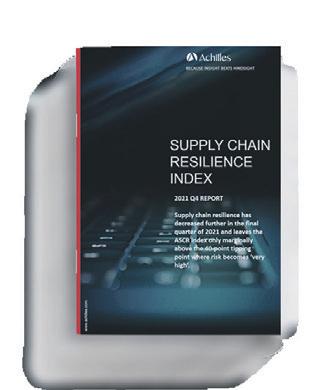
Ensuring the agility and resilience of your business and supply chain starts with identifying the risks.

Download our report to start your resilience planning today.
Download ASCRI Report